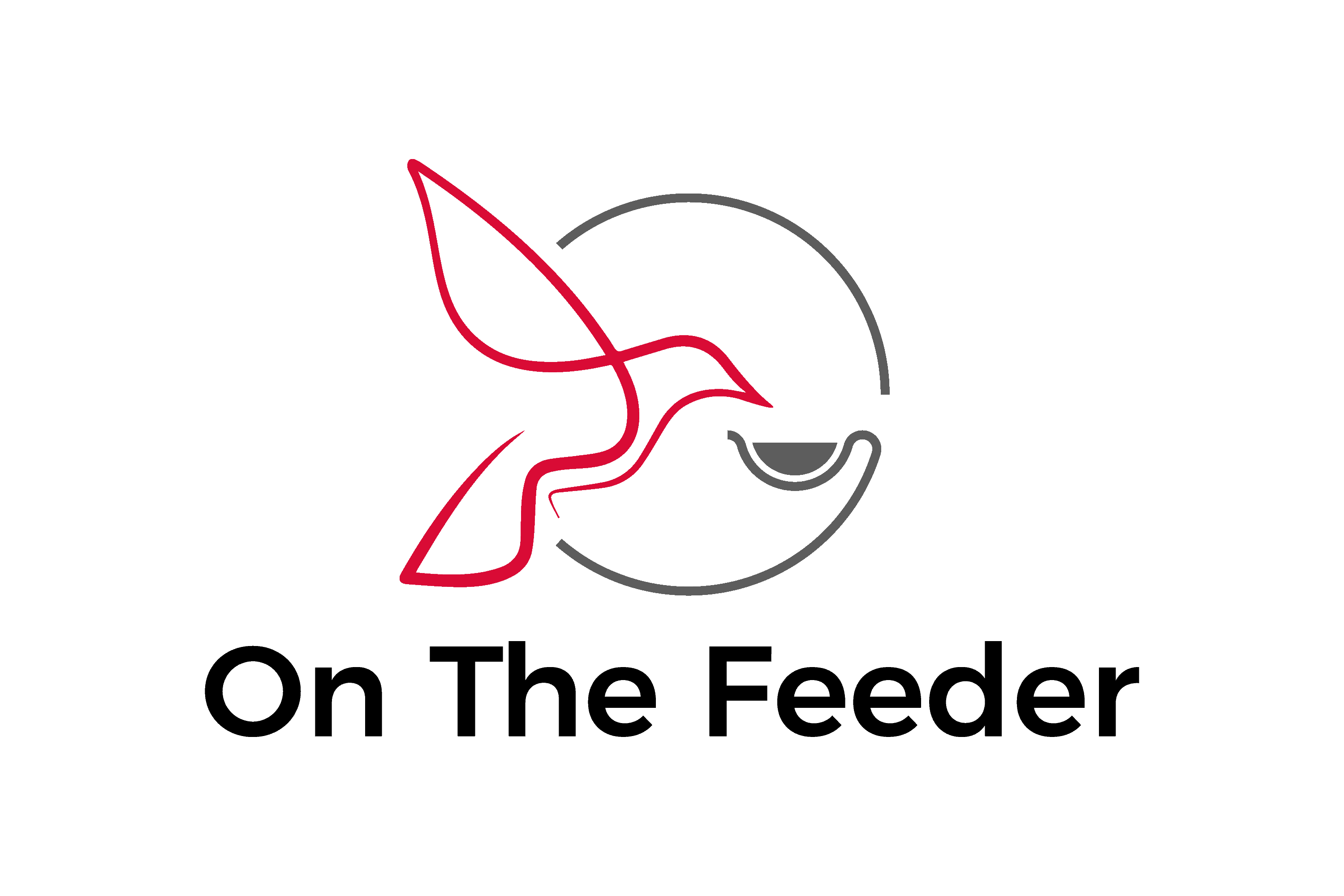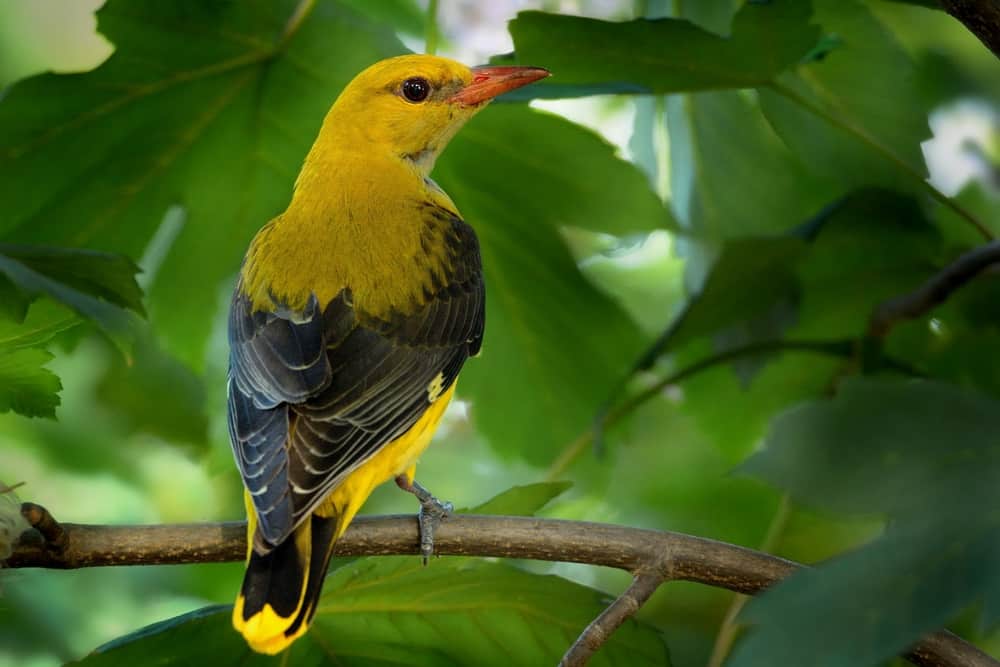So you spotted a yellow bird with black wings and wondered what type it is. Congrats – you’re in the right place! This article includes the 21 species of yellow birds with black wings found in the US and Canada.
The bird could be entirely yellow or partly yellow, bright yellow, dark yellow, or greenish-yellow. It could have black wings or charcoal wings. It could be the female or male of the species. They are all here!
Below are the 21 yellow birds with black wings.
- American goldfinch
- Audubon’s oriole
- Baltimore oriole (female)
- Black-throated green warbler
- Bullock’s oriole (female)
- Common yellowthroat
- Eastern meadowlark
- Evening grosbeak
- Golden-crowned kinglet
- Hooded oriole (female)
- Lesser goldfinch
- Magnolia warbler
- Orchard oriole (female)
- Prothonotary warbler
- Scarlet tanager (female)
- Scott’s oriole
- Townsend’s warbler
- Western tanager
- Wildson’s warbler
- Yellow warbler
- Yellow-headed blackbird
Now that you know the possible bird species, the next step is to identify it. Shortly you’ll discover a photo of each bird, details about habitat, diet, nesting habits, and a range map to show you where you may see them.
The range maps are color-coded so you know if it’s a year-round bird, there to breed, migrating through, or there during a non-breeding time.

With more than 25 years of experience attracting backyard birds to my yard in Wisconsin, I’ve studied all of the yellow birds with black wings in my area so I have the information you’re looking for. For the remaining species, I rely on my trusty sourcebooks and friends at The Cornell Lab of Ornithology to guide me.
Yellow Birds With Black Wings
American Goldfinch
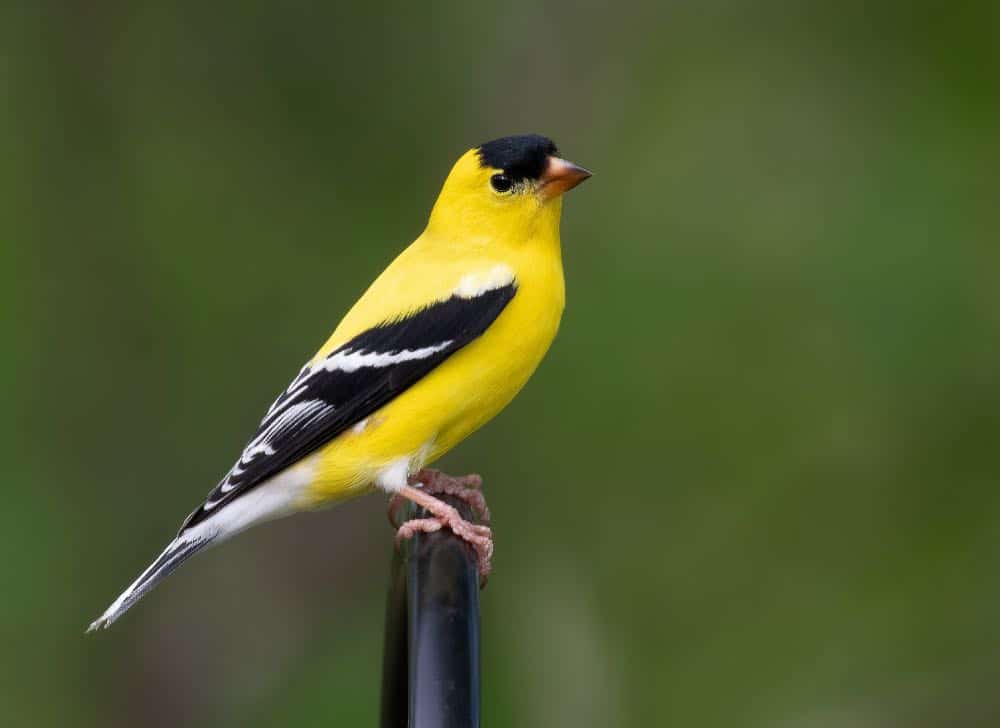
Appearance: The American goldfinch is a small bird about 4.5″ long, bright yellow body, black wings with white stripes, a black forehead, short orange beak. During winter has a dingy brown body, duller yellow head, and thicker white stripes on its wings. Breeding females are similar to males except their bodies are lemon yellow and their wings have more white tips
Diet: Seeds from flowers, weeds, grasses, and small trees. Some insects.
Feeder food: Thistle seed (Nyjer)
Habitat: American goldfinch is a common bird throughout the contiguous US and southern part of Canada. Weedy fields, roadsides, orchards, and backyards.
Nesting:
- Nest: American goldfinches build their nest in a deciduous shrub or tree, sometimes conifers, placed on a branch’s fork as high as 20′.
- Broods: 1-2 broods/season
- Clutch: 2-7 eggs per brood
- Egg color: Very pale blue to white, occasionally faint brown spots on the larger end.
- Egg size: 0.5 inches by 0.5 inches
- Incubation: The female incubates the eggs for about 12-14 days while the male brings food to the female.
Migration: American goldfinches are partial migrators. Many remain in their year-round range for all seasons of the year while others migrate north to breed in spring and then migrate south for the winter.
Year-round range: Washington, Idaho, Oregon, Montana, Wyoming, Nevada, Utah, Colorado, Kansas, Nebraska, Oklahoma, and the remaining US states to the east and south (except Florida).
Breeding range: Northwest Washington, Montana, North Dakota, South Dakota, Kansas, northern Minnesota & Michigan, as well as the southern Canada provinces.
Winter range: Western Oregon, California, southern Nevada & Utah, Colorado, Arizona, New Mexico, Texas, southern Louisiana, Mississippi, Alabama, Georgia, South Carolina, and the state of Florida.
Range Map
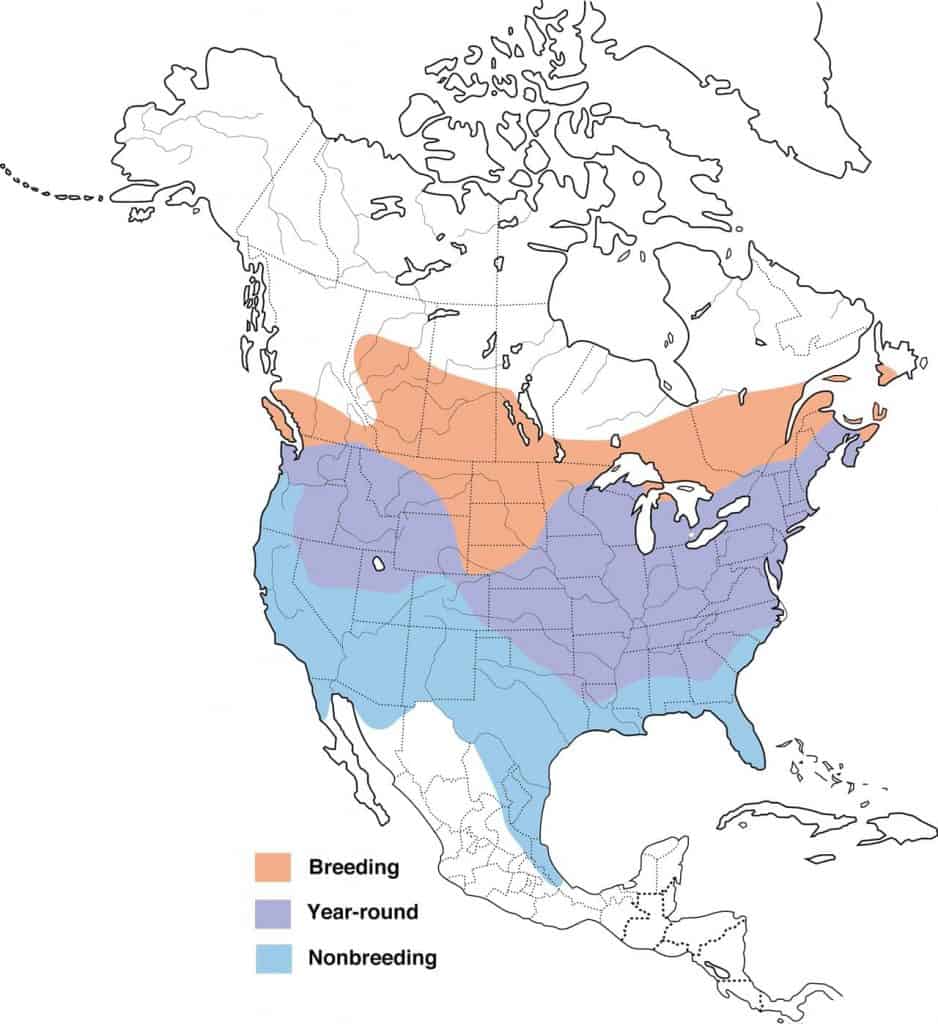
Audubon’s Oriole
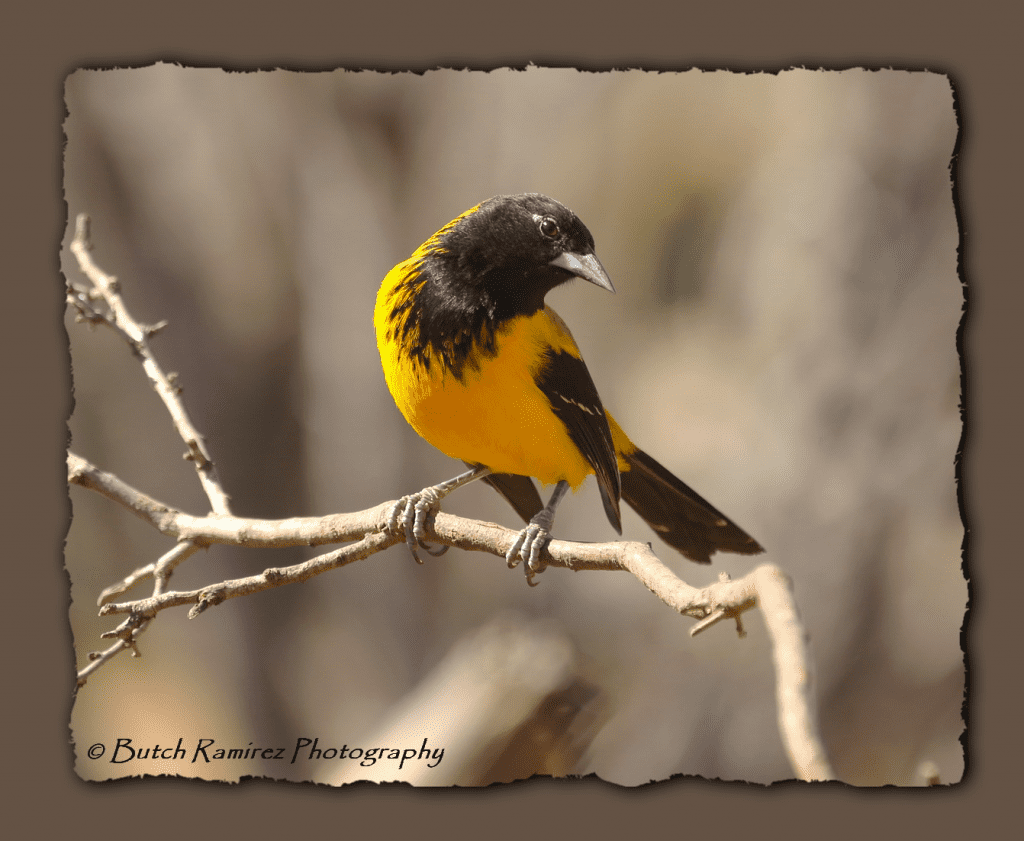
| Appearance | The Audubon’s oriole is a medium-sized bird about 7.5-9.5″ long with an orange-yellow body and black on its head, wings, and tail. Wings are also striped with white. The bill is long, pointy, and curved downward. The females look the same but a bit more subdued in color. |
| Diet | Insects, berries, and occasionally flower nectar. |
| Feeder Food | Sugar-water nectar and sunflower seeds. |
| Habitat | Wooded and brushy areas especially along the water. |
| Nesting | Their pouch-style nests are suspended on the outer branches about 5-15′ up in a tree. They have about 3-5 eggs that are blue/white with dark streeks and speckles. |
Range Map
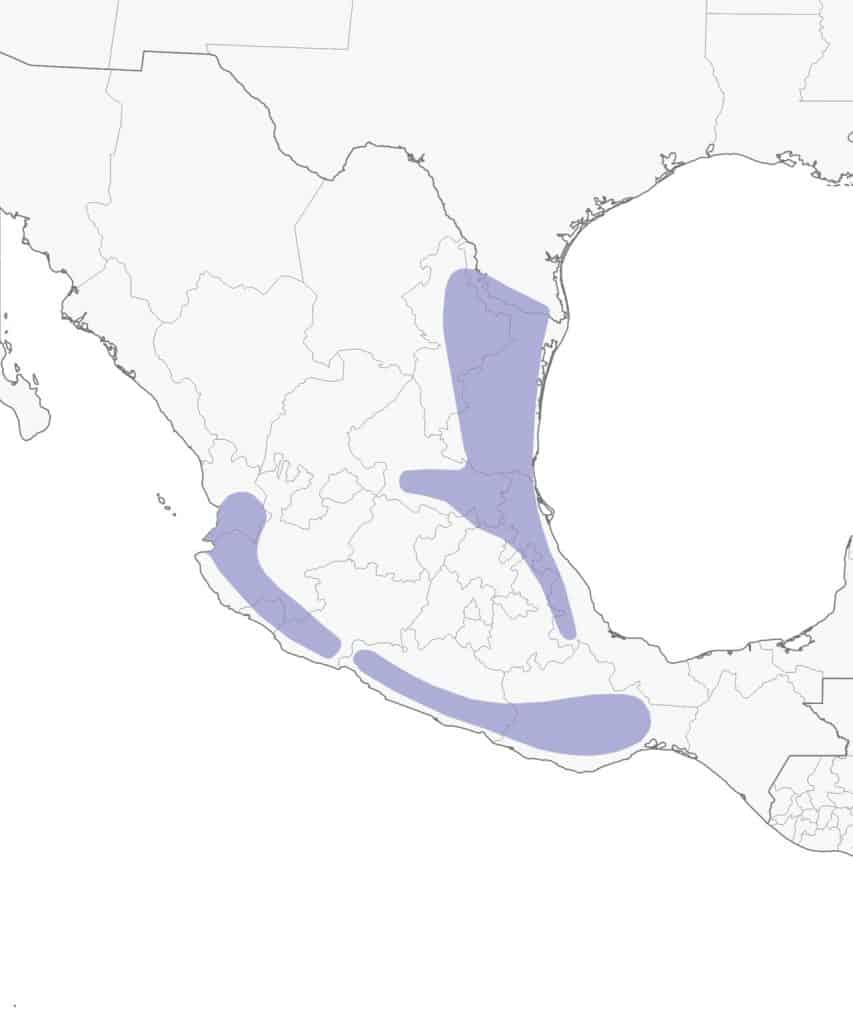
Baltimore Oriole
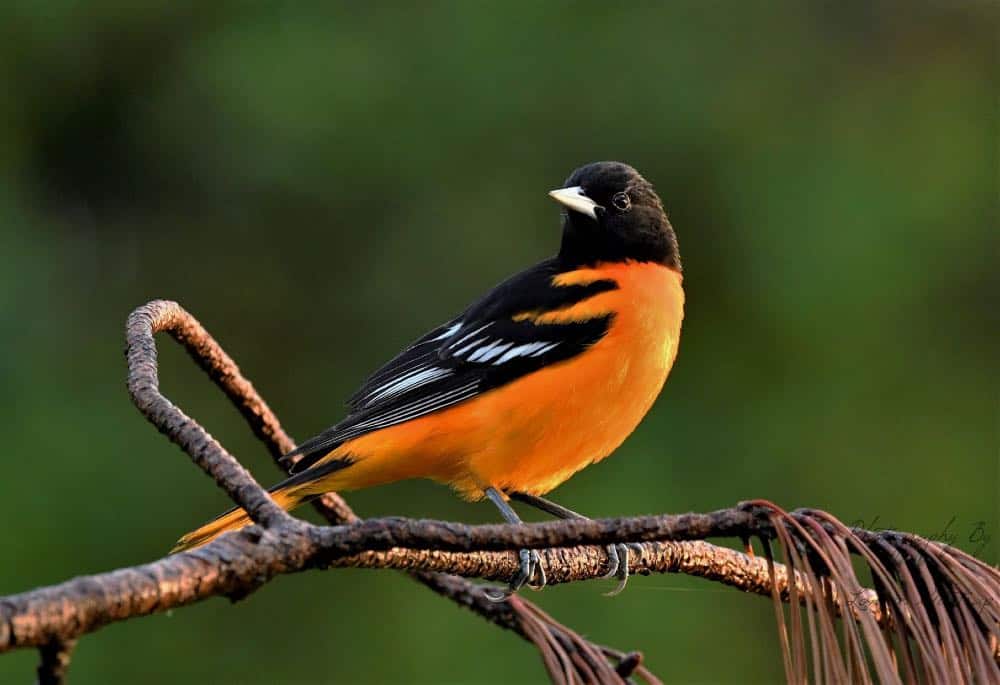
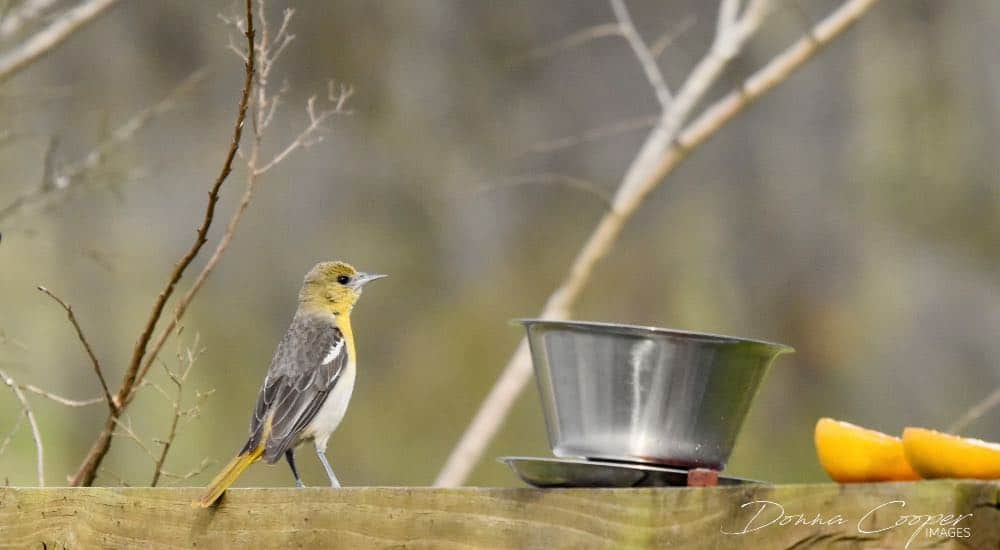
| Appearance | Medium-sized bird about 8.25″ long. Male Baltimore orioles have a flaming orange body and black head with black and white wing bars. The tail is orange with black and white streaks. The female and juvenile birds have pale yellow heads and bodies with grayish-brown wings and white wing bars. Both genders have a gray bill and dark eyes. |
| Diet | Insects, berries, and nectar from flowers. |
| Feeder Food | Baltimore Orioles will eat sweet foods such as nectar, oranges, and regular grape jelly. |
| Habitat | Baltimore orioles can be found in residential areas and wooded edges rich with high, deciduous shade trees – especially during breeding. They often nest near natural water sources such as ponds and rivers. |
| Nesting | The female builds a 4-6″ hanging long purse-style nest suspended on the end of a forked branch and only has one brood per year. About 4-5 bluish-colored eggs with brown markings are incubated for 12-14 days. |
Range Map
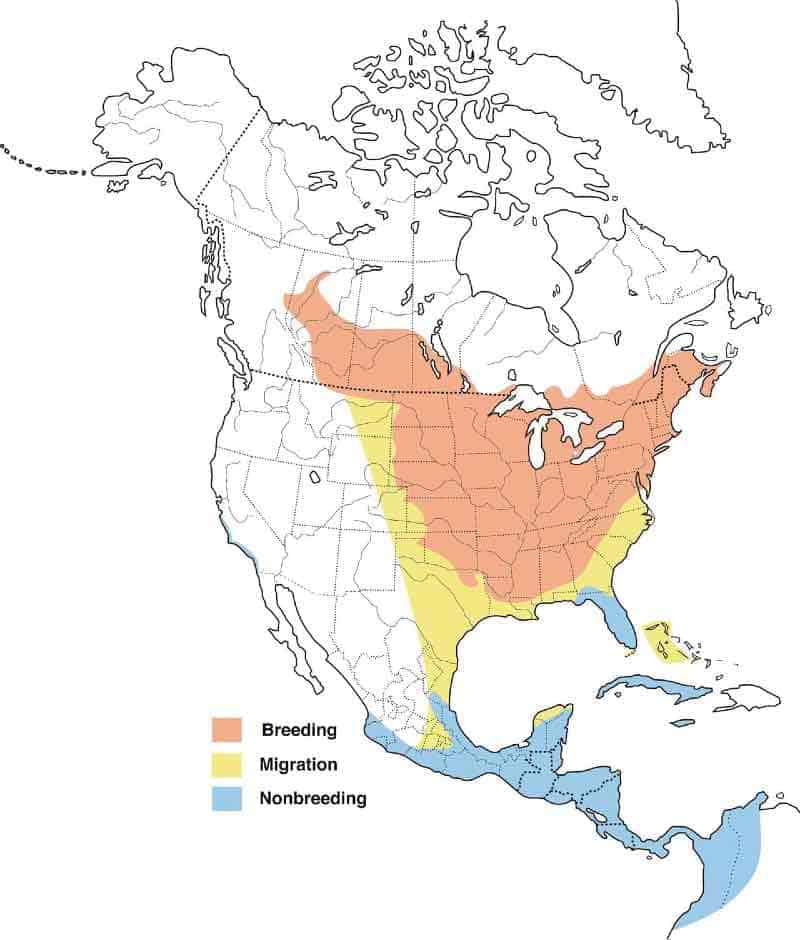
Black-Throated Green Warbler
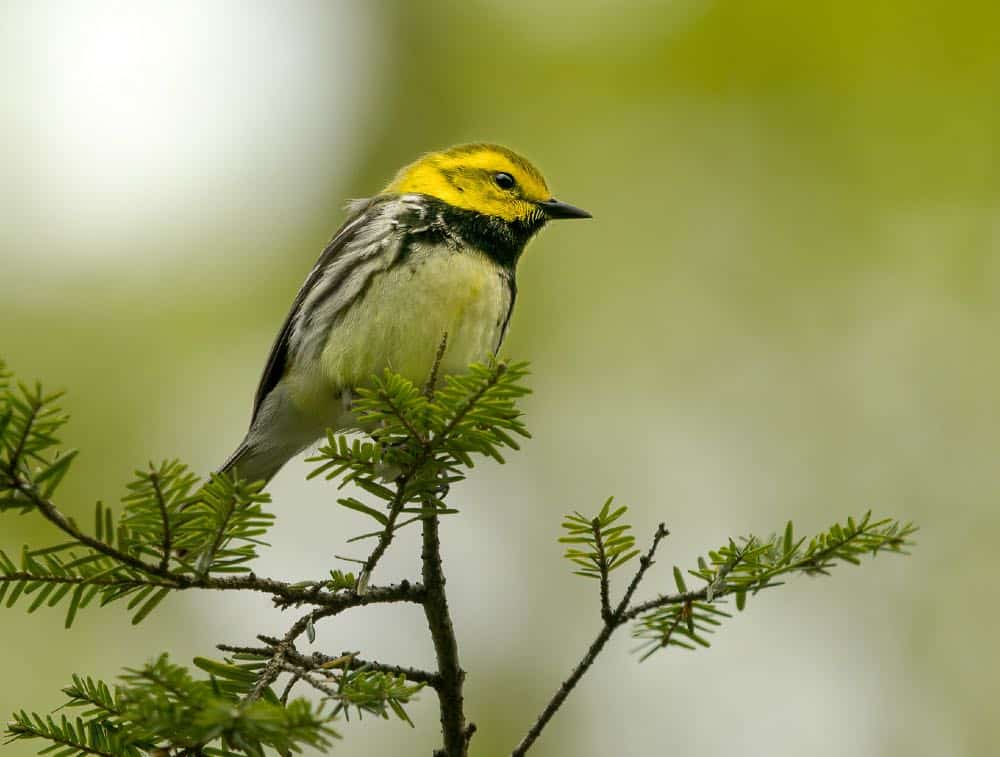
| Appearance | Small bird about 4.5″ long with a bright yellow head, black throat, and green back. Black and white streaks over the sides. The female is similar but has a white throat. |
| Diet | Primarily insects. Will dine on berries while migrating. |
| Feeder Food | Unlikely to visit a feeder. |
| Habitat | They prefer forests with a mix of coniferous and other deciduous trees. |
| Nesting | The female builds a small cup-shaped nest 3-10′ off the ground in a tree. They have one brood/year. There are about 3-5 tiny eggs, white with brown spots. Incubation is 12 days. |
Range Map
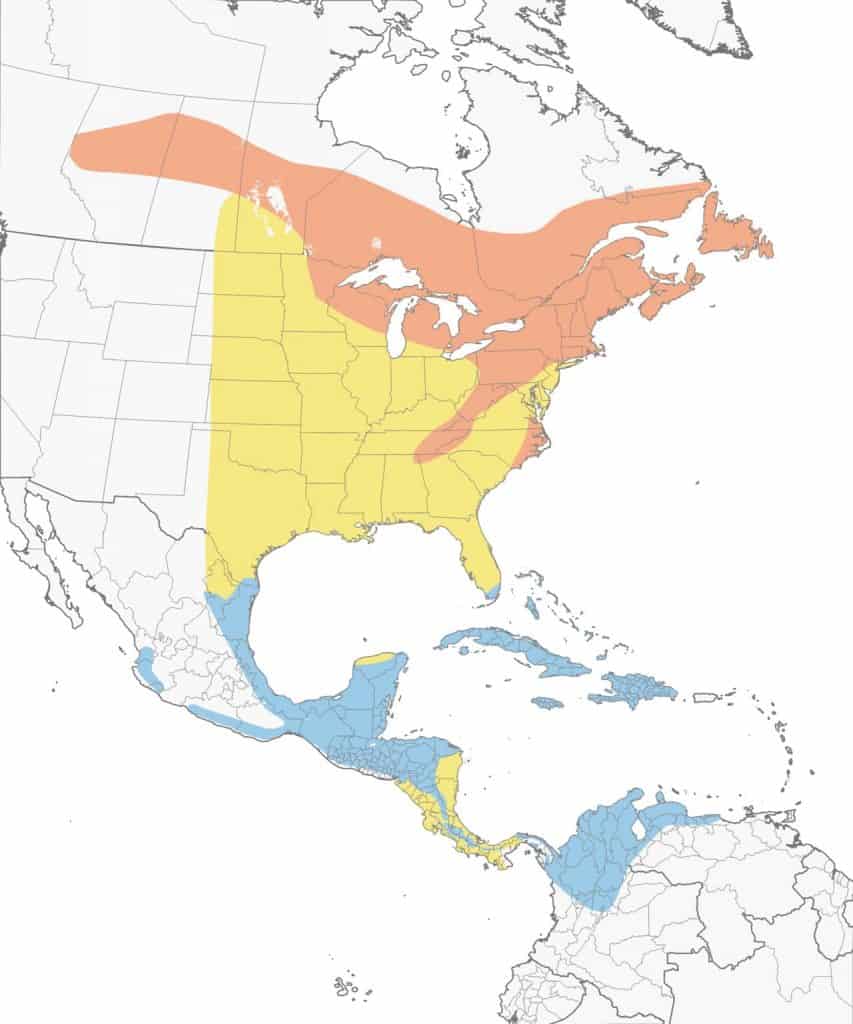
Bullock’s Oriole
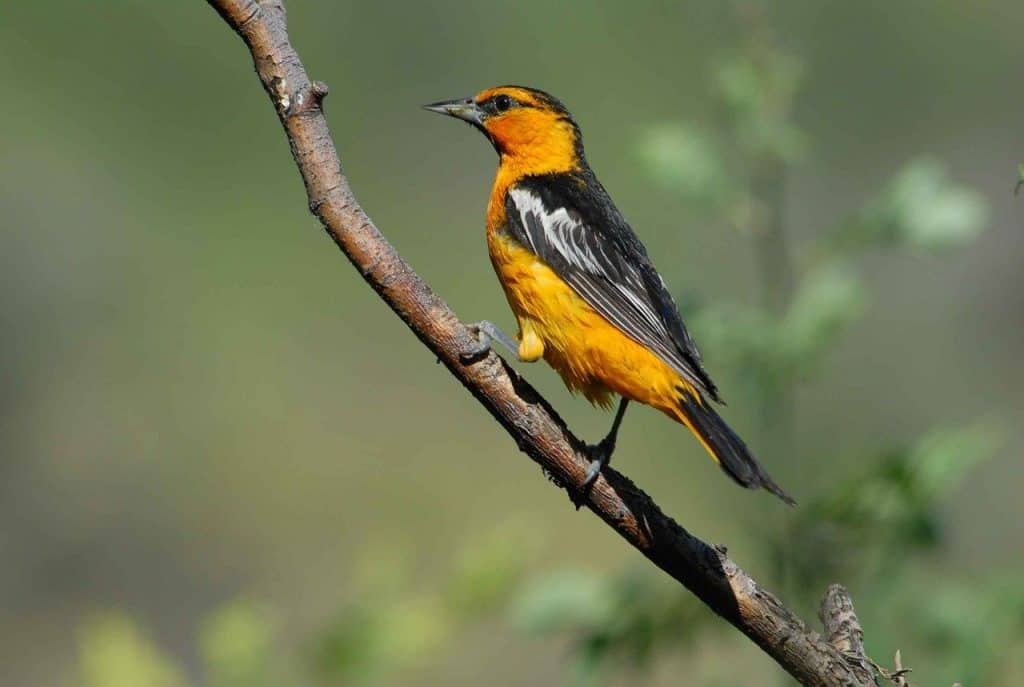
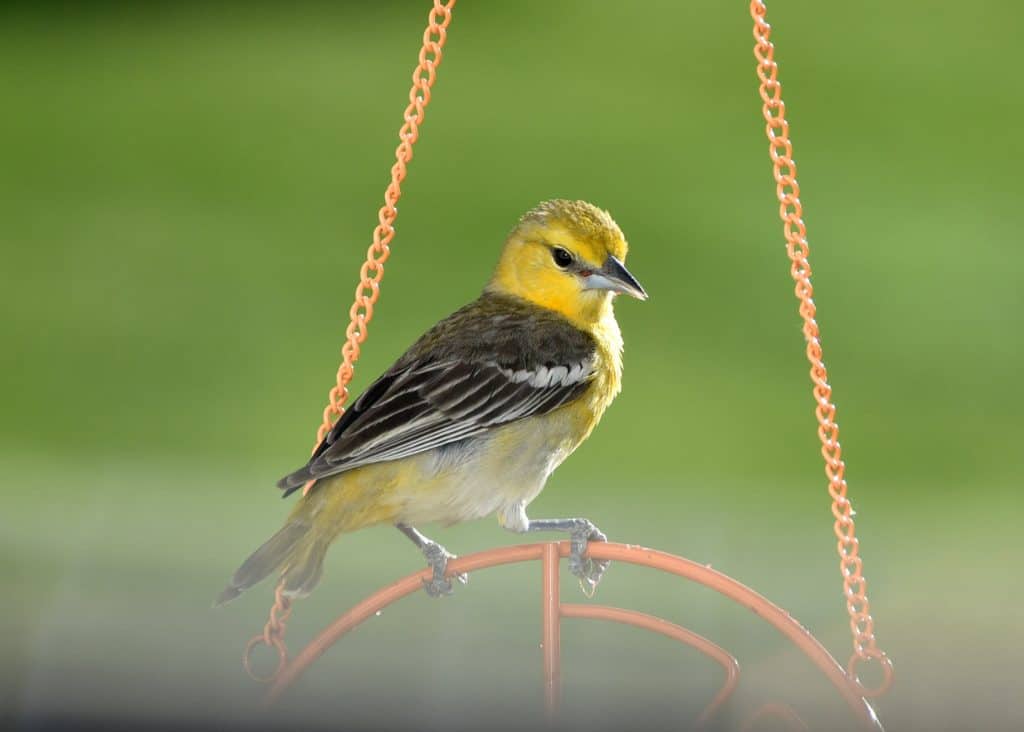
| Appearance | The Bullock’s oriole is a medium-sized bird about 8″ long. They’re orange with a black crown, eye stripes, throat, back, and wings (+ white wingbars). During the first spring, a juvenile male is more yellow-orange with a black mask and throat. The female is yellow with a dark stripe through the middle her eyes, and grayish-black only on her wings. White wingbars accent the black. |
| Diet | Insects, spiders, fruits, and nectar. |
| Feeder Food | Cut fruit, jelly, or nectar. |
| Habitat | Open wooded areas especially along riverbanks. |
| Nesting | Bullock’s orioles build a hanging pouch style nest about 10-20′ high in a tree or shrub and is suspended from a forked branch. They have 4-5 eggs/brood that are incubated for 11-14 days. The eggs are pale blue/white with purplish-brown spots. Fledglings leave the nest at about 14 days. |
Range Map
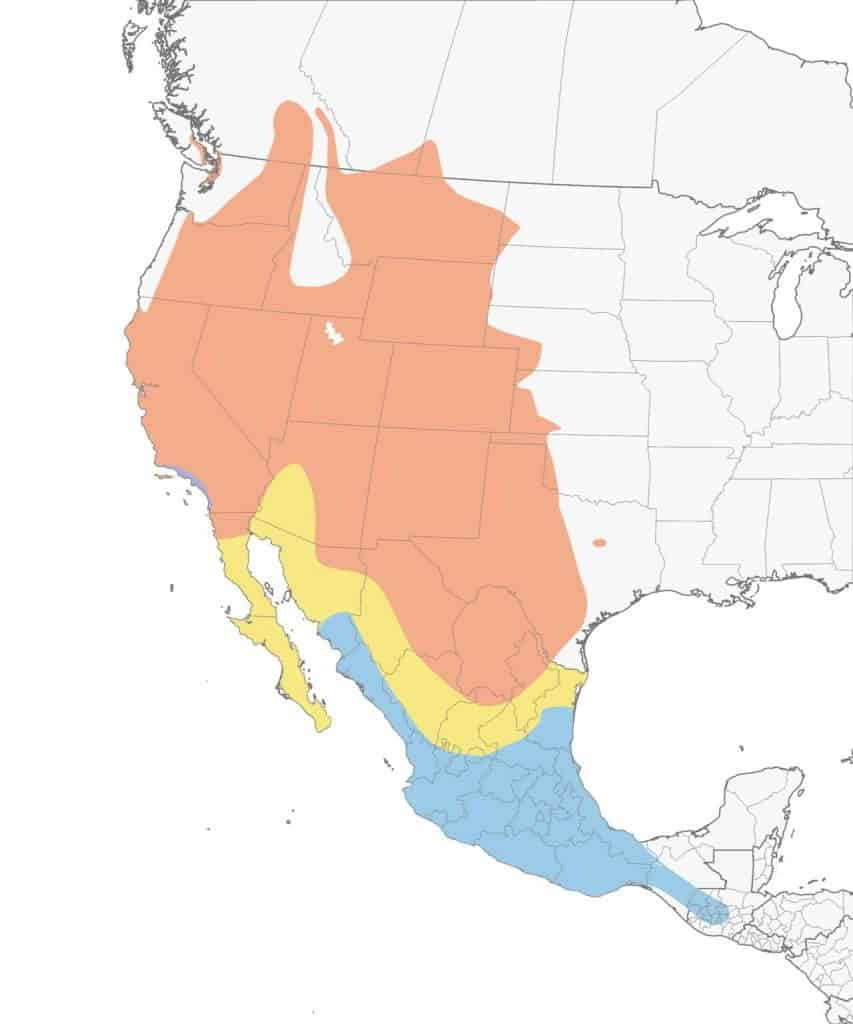
Common Yellowthroat
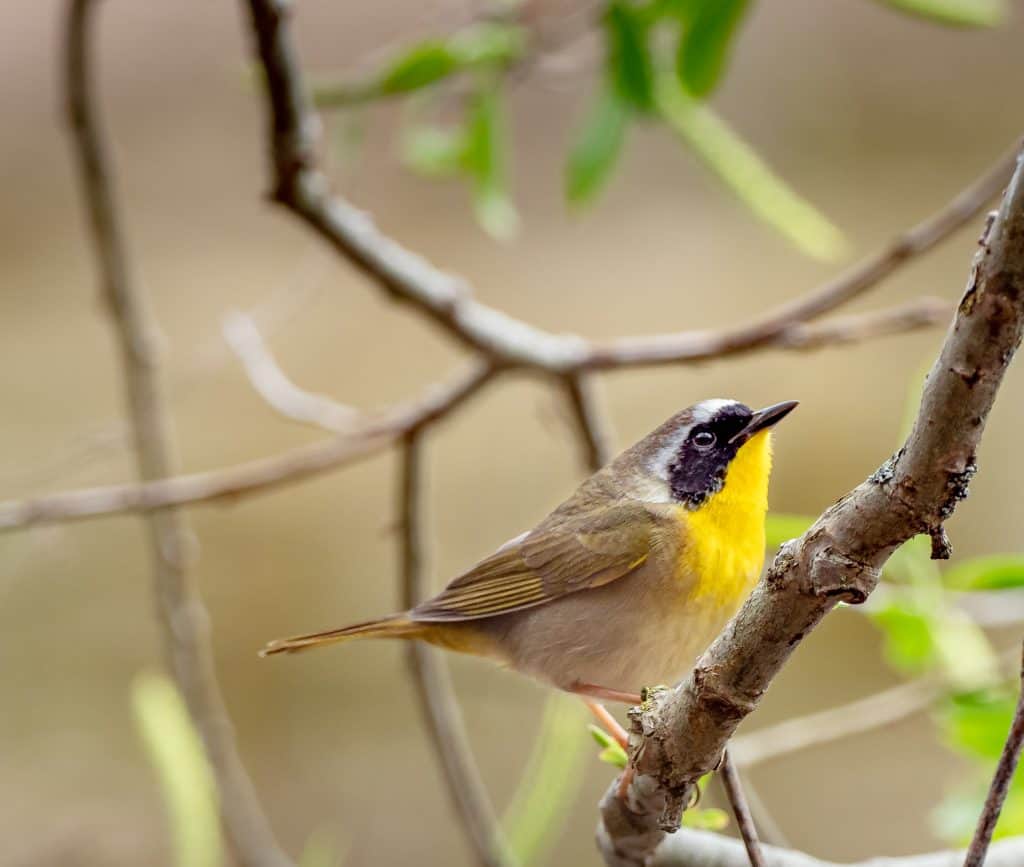
| Appearance | Small bird about 5″ long, olive-brown color with bright yellow throat and breast, and white belly. Black mask outlined in white. Long, thin, and pointy black bill. The Female is the same except with no black mask. |
| Diet | Insects. |
| Feeder Food | Unlikely to visit a feeder. |
| Habitat | Common in thick brush, open fields, and marshes. |
| Nesting | Cup-shaped nest located near the ground, often in a thick shrub. They have 2 broods/year, 1-6 eggs/brood, eggs are white with brown markings, and incubation lasts 11-12 days. |
Range Map
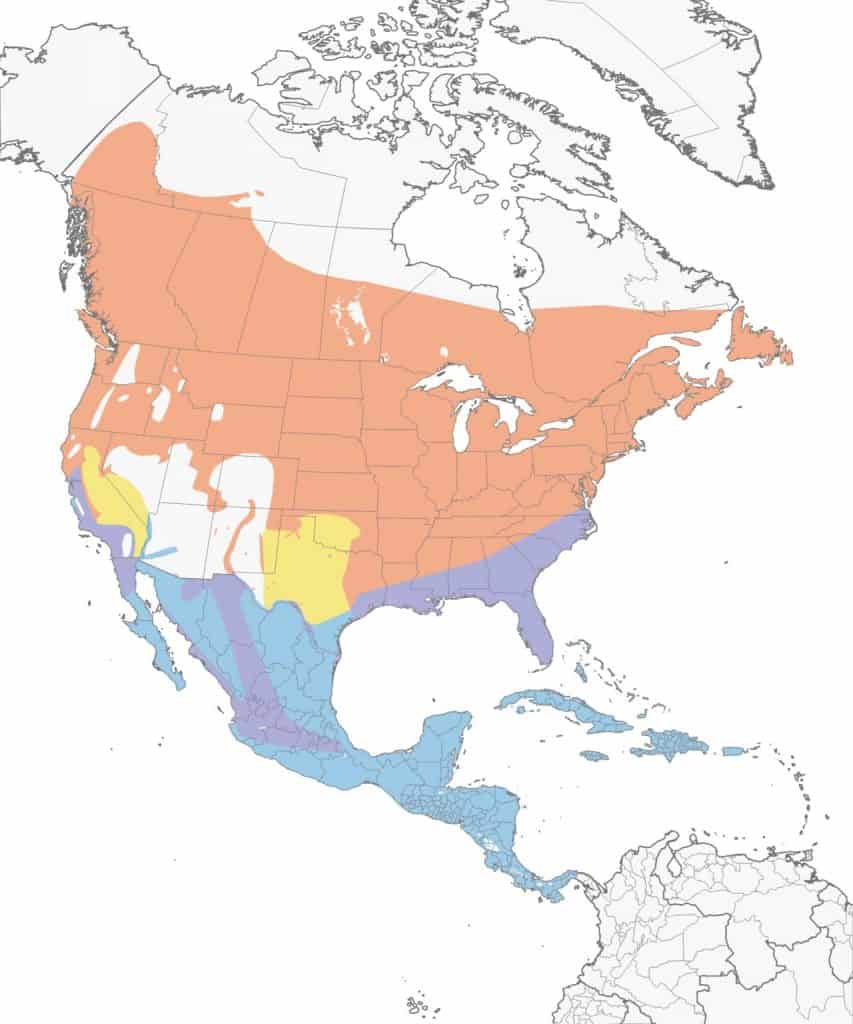
Eastern Meadowlark
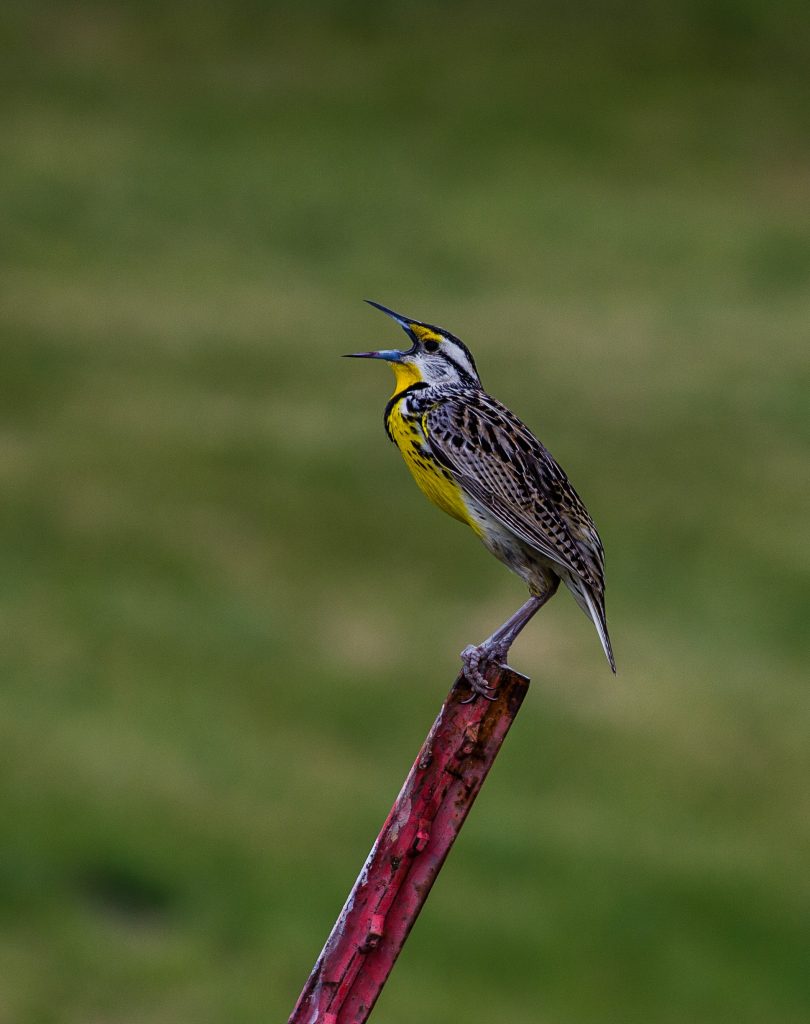
| Appearance | Large bird about 9″ long with brown back, lemon yellow-colored chest, and black v-shape around the neck. White outer tail feathers. Female and male look the same. |
| Diet | Insects and seeds. |
| Feeder Food | Hulled sunflower seeds and cracked corn. |
| Habitat | Open grassy areas. |
| Nesting | Cup-shaped nest on the ground within a dense cover. They have 2 broods/year and 3-5 eggs/brood. Eggs are white with brown markings and incubation lasts 13-15 days. |
Range Map
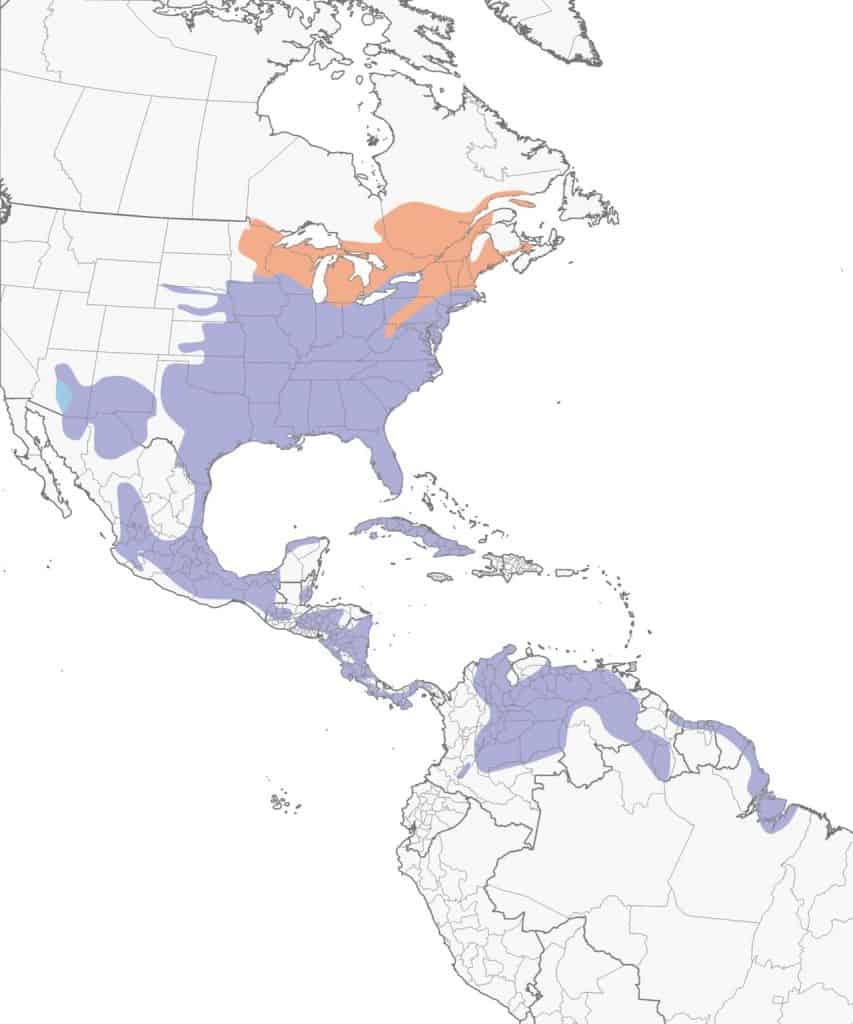
Evening Grosbeak
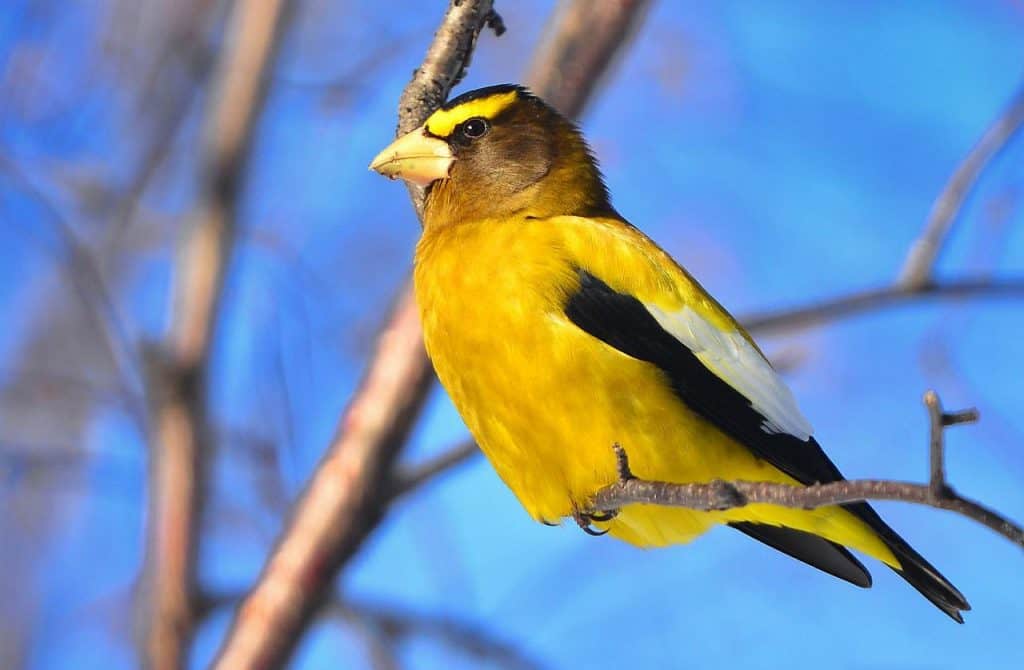
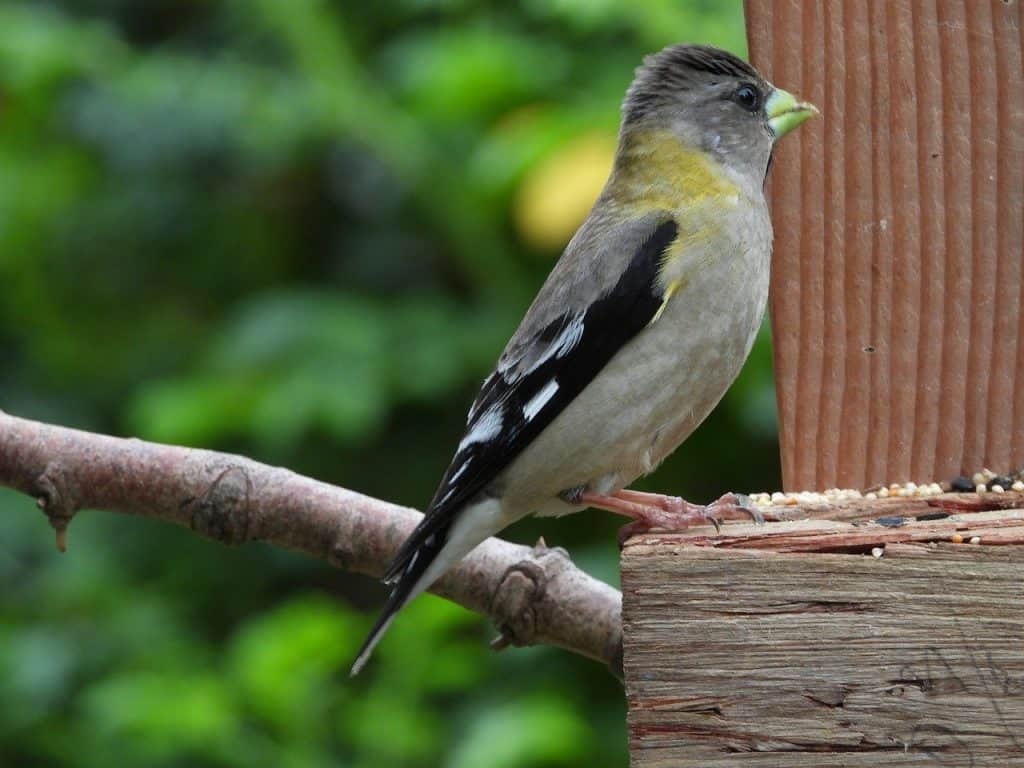
| Appearance | The evening grosbeak is a medium-sized bird about 8″ long. They have an olive-yellow head with a yellow streek above each eye extending across and above the bill. The wings and tail are black and white. The belly and rump are bright yellows. their beak is large, stocky, and yellow-blue/green. The female has softer colors than the male and has a gray head and throat instead. |
| Diet | Seeds, insects, fruit. |
| Feeder Food | Black-oil sunflower seeds and hulled sunflower seeds |
| Habitat | Forested areas |
| Nesting | Cup-shaped nest. They have 1 brood/season with 3-4 blue eggs with brown spots in each brood. Incubation is 12-14 days. |
Range Map
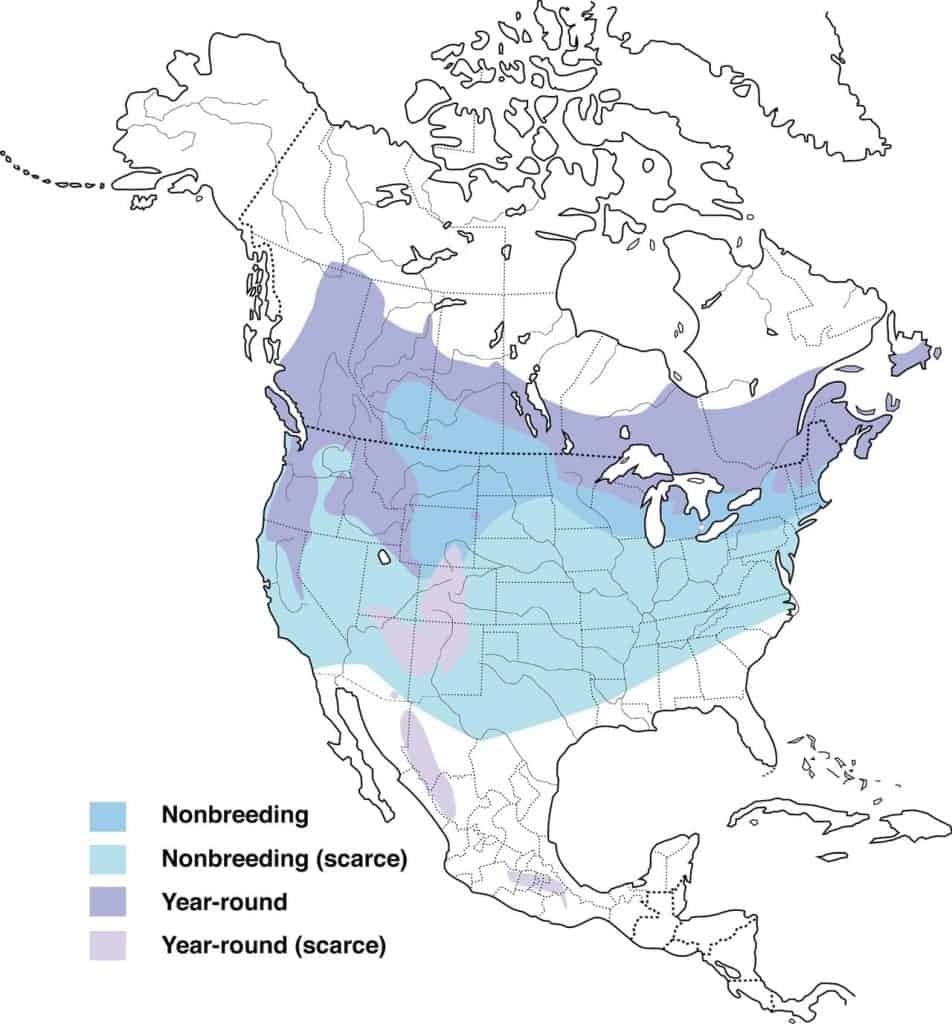
Golden-Crowned Kinglet
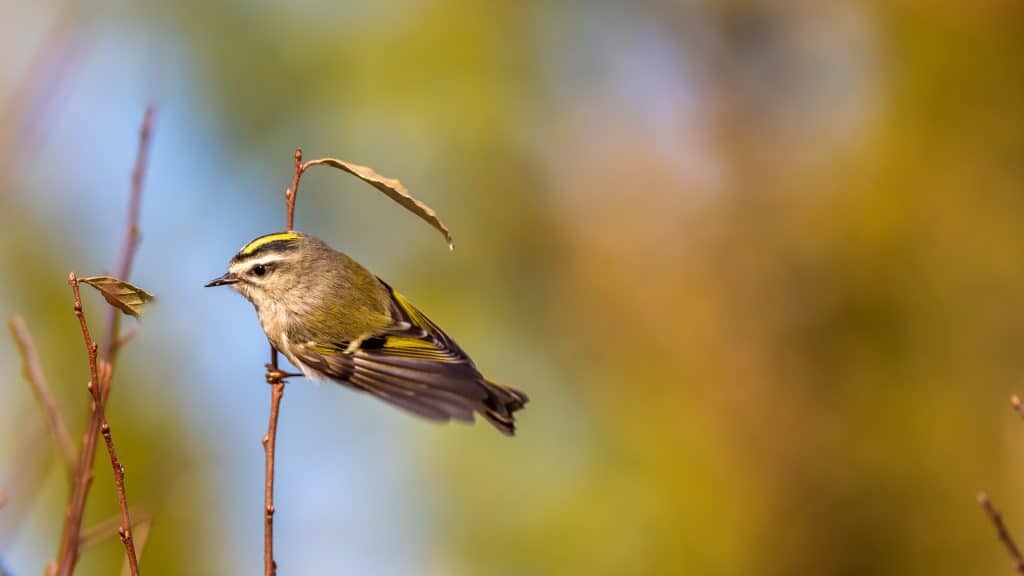
Appearance: Golden-crowned kinglets are small birds about 4″ long, olive-green in color with crowns striped with reddish/orange and white stripes above & below the eyes. Females are the same except for their crowns are yellow instead
Diet: Insects and spiders.
Feeder food: Suet.
Habitat: In their year-round area, they generally inhabit mountainous regions with abundant coniferous trees. They nest in mixed forested areas and within small groups of trees with minimal or no undergrowth.
Nesting: The golden-crowned kinglet builds a 3″x3″ cup-shaped, deep nest and places it at the intersection of several branches. They have 1-2 broods/season and 7-8 eggs/brood that are white/cream colored with specks of brown or lavender. Incubation lasts 15 days.
Migration: Golden-crowned kinglets are migrators. While many remain in their year-round range every season of the year, others migrate. The migrators head north into Canada, northern Minnesota, Michigan & Wisconsin for breeding in springtime then head south to the rest of the US for winter months.
Year-round range: Pacific coast of Alaska, British Columbia, Washington, Oregon, California, Idaho, eastern Oregon, western Montana, Utah, Colorado, Arizona, New Mexico, New England, and Mexico.
Breeding range: Canada (except Nunavut), southeast Alaska, northern Minnesota, Michigan & Wisconsin.
Winter range: All US states, southern Alberta, Saskatchewan, Manitoba, and the northern part of Mexico.
Range Map
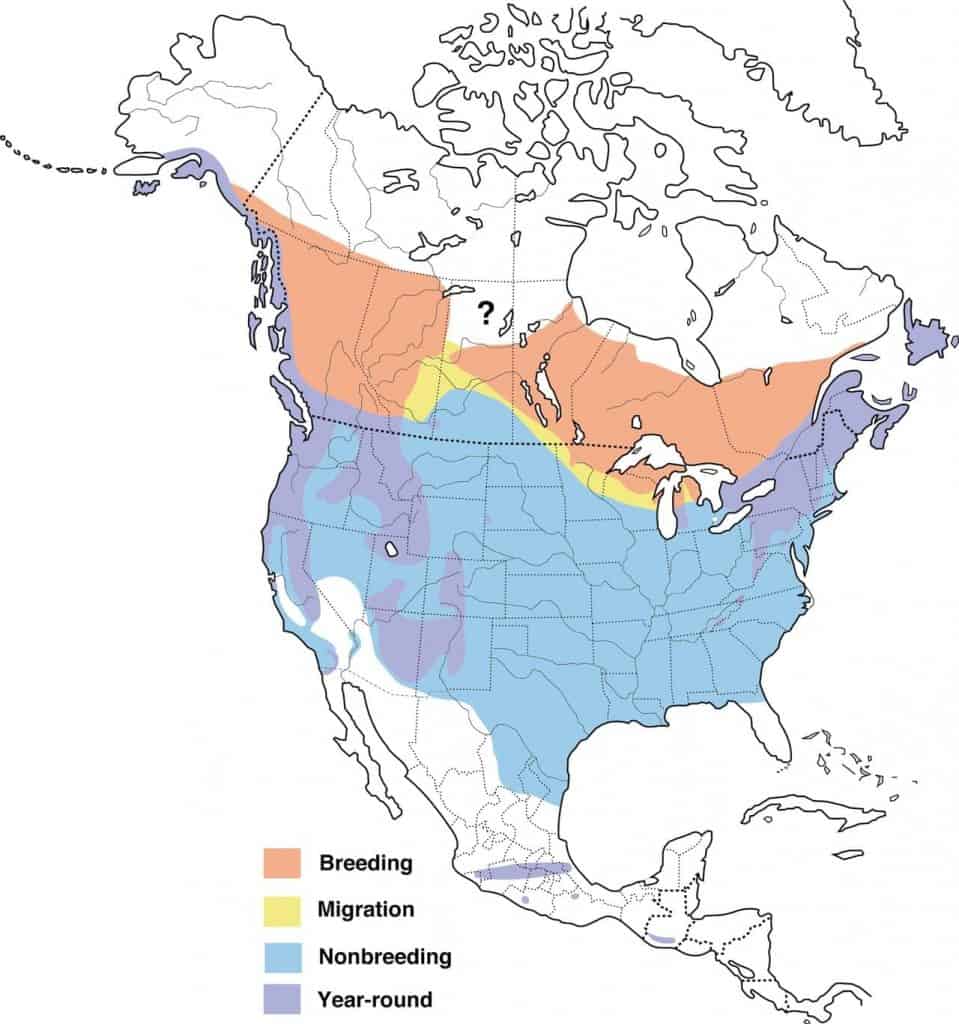
Hooded Oriole
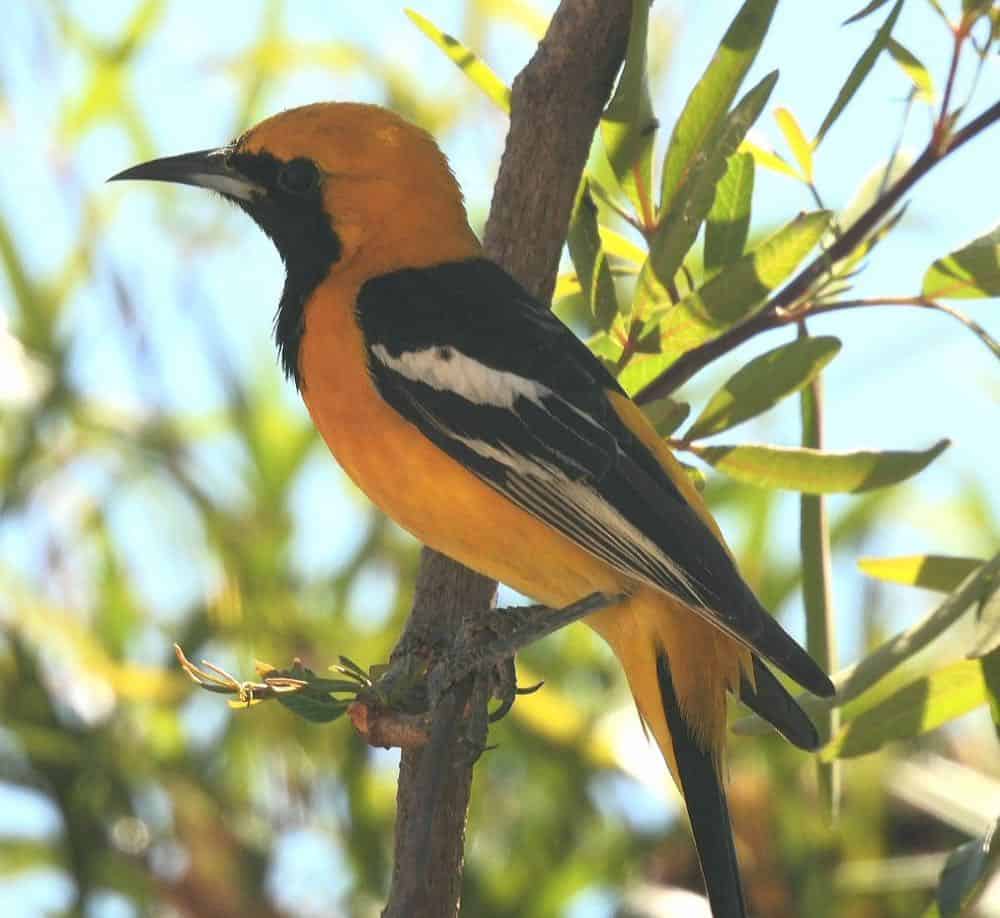
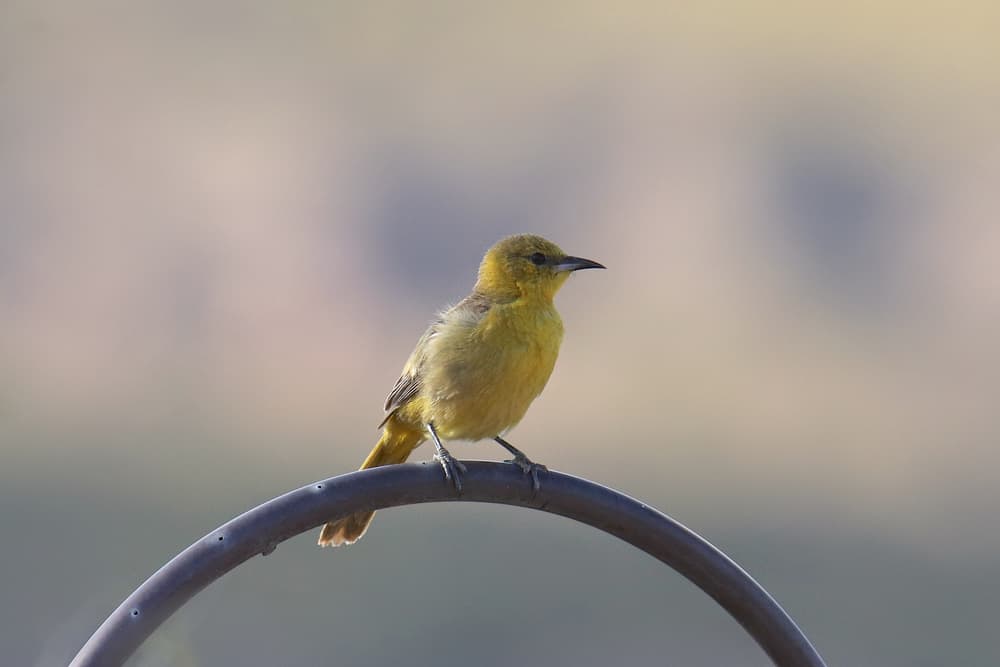
| Appearance | Hooded Orioles are medium-sized- birds about 8″ long. The male is a deep orange with a black face, throat, wings (+ white wingbars), and long tail. They also have a long pointy turned down bil. • A juvenile male is the same with bright yellow instead of orange. • The female is yellow with an olive back and black wings with white wingbars. |
| Diet | Insects, spiders, fruits, and nectar. |
| Feeder Food | Fruit and nectar. |
| Habitat | Open, dry areas with scattered trees – especially palm trees. |
| Nesting | These birds nest in shade trees, palm trees, or large shrubs about 10-45′ up. The nest is a suspended cup-style. They have 1-2 broods/season and 4 eggs/brood that are whitish to pale blue with dark blotches. Incubation is for about 13 days. Fledglings leave the nest at about 14 days. |
Range Map
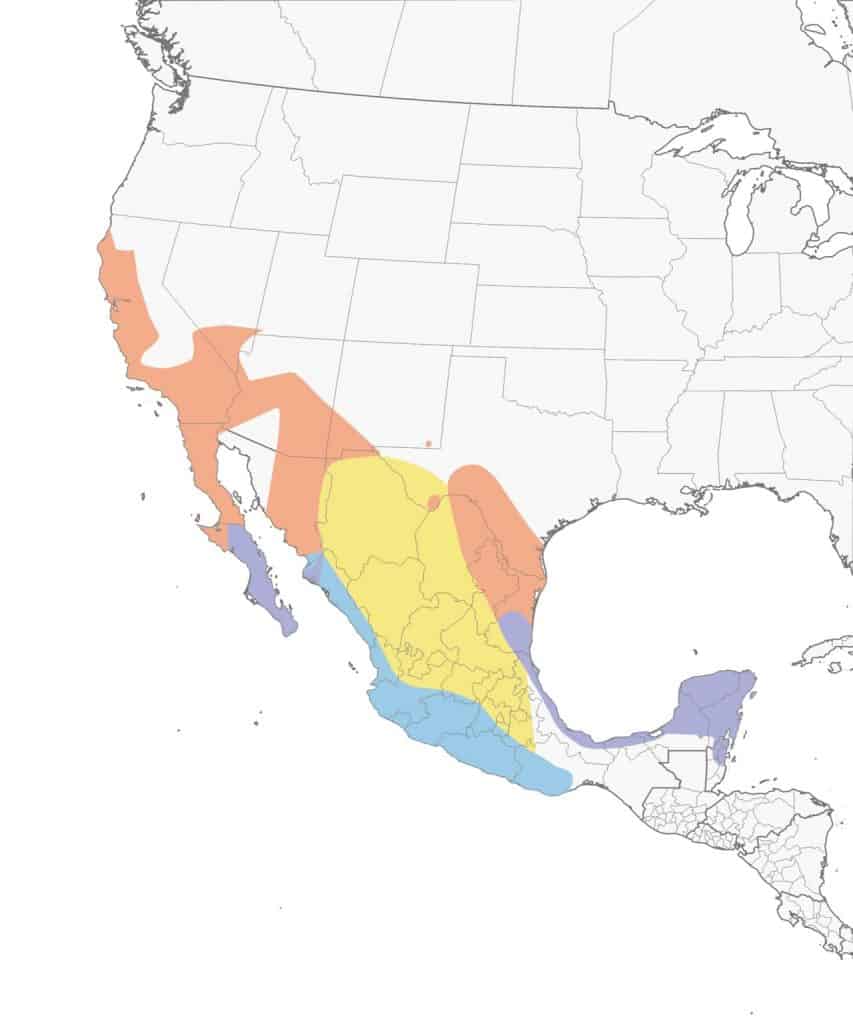
Lesser Goldfinch
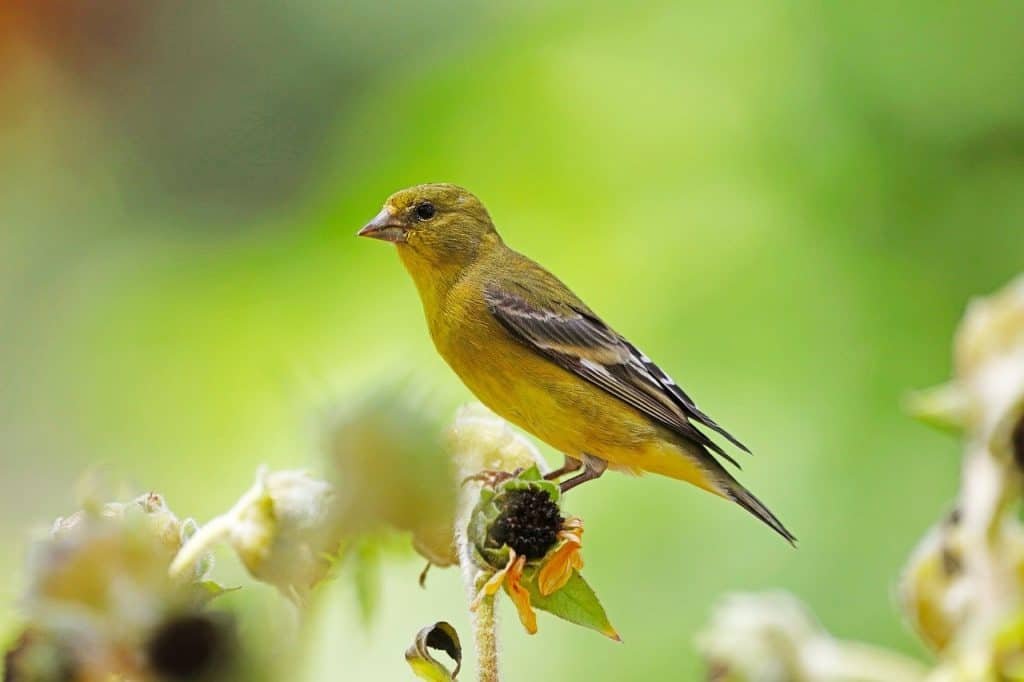
| Appearance | Small bird about 4.5″ long with an olive-green body, yellow belly, and black wings with white patches. There are two sub-species of the lesser goldfinch. • The black-backed is found from Colorado to Texas and has black underparts and a yellow belly. • The green-backed is found in the southwest and west coast and has a black cap but an olive-green back and a yellow belly. • The green-backed is found in the southwest and west coast and has a black cap but an olive-green back and a yellow belly. The female is the same except for a duller olive green. |
| Diet | Seeds, tree buds, berries, and occasionally insects. |
| Feeder Food | Nyjer seed |
| Habitat | Enjoy a variety of habitats at different elevations and can be found in backyards with plenty of seed-bearing vegetation. |
| Nesting | Nest: Lesser goldfinches build a compact cup-shaped nest and place about 50-30′ high in a tree or shrub – typically in forked branches. Broods: 1 brood/season Clutch: 3-6 eggs/brood Egg color: Pale blue-white without markings Egg size: 0.6 inches by 0.4 – 0.5 inches Incubation: 12 days. |
Range Map
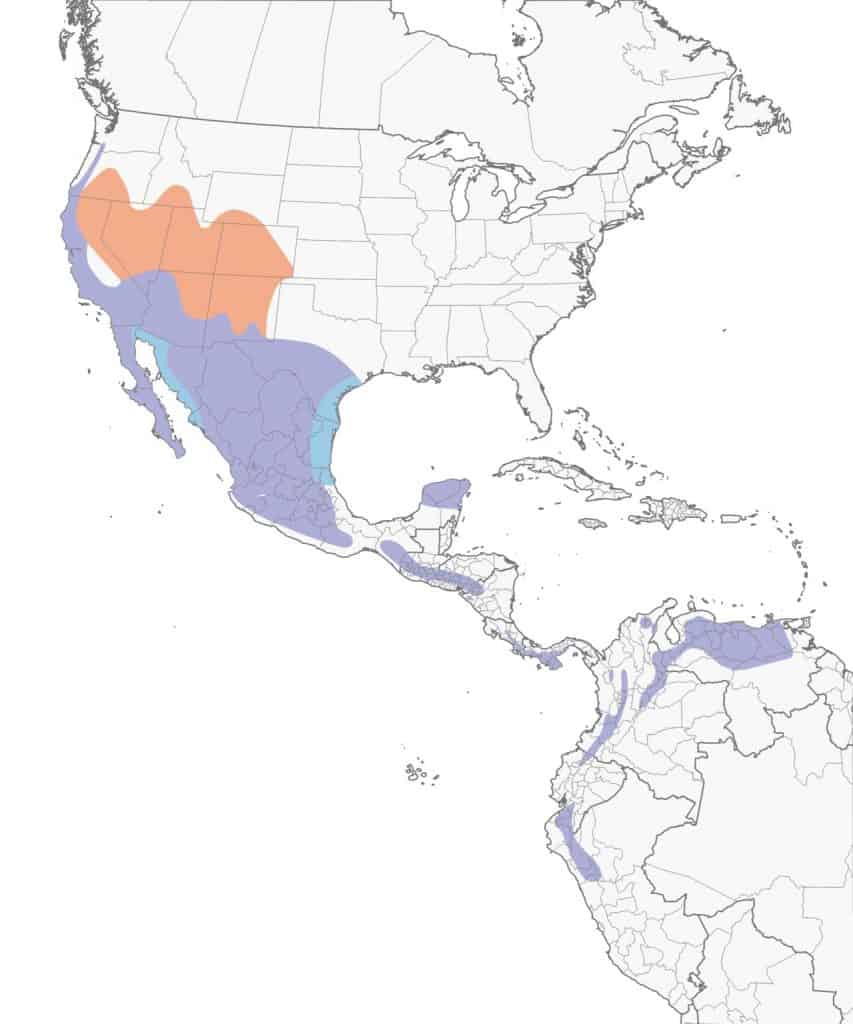
Magnolia Warbler
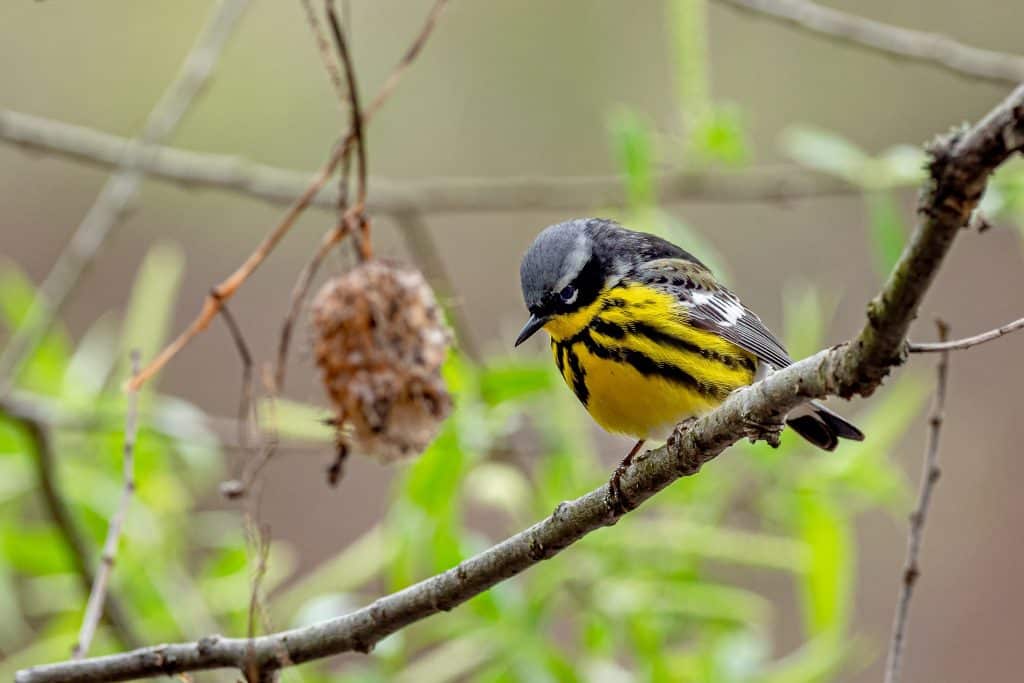
| Appearance | Small bird about 5″ long with slate gray top and bright yellow under with black stripes. A black mask surrounds the eyes with a white strip above that. Short pointy bill and long, narrow tail. The female is lighter gray with a yellow belly but only a faint black stripe. She has no black mask, her eyes have white eye rings and splotches of yellow on her back. |
| Diet | Insects and sometimes fruit in fall. |
| Feeder Food | Unlike to visit feeders. |
| Habitat | Thickly forested areas with conifer trees. |
| Nesting | They nest deep in coniferous trees. They have 1-2 broods/year, 3-5 eggs/brood that are white some speckled. Incubation lasts 11-13 days. |
Range Map
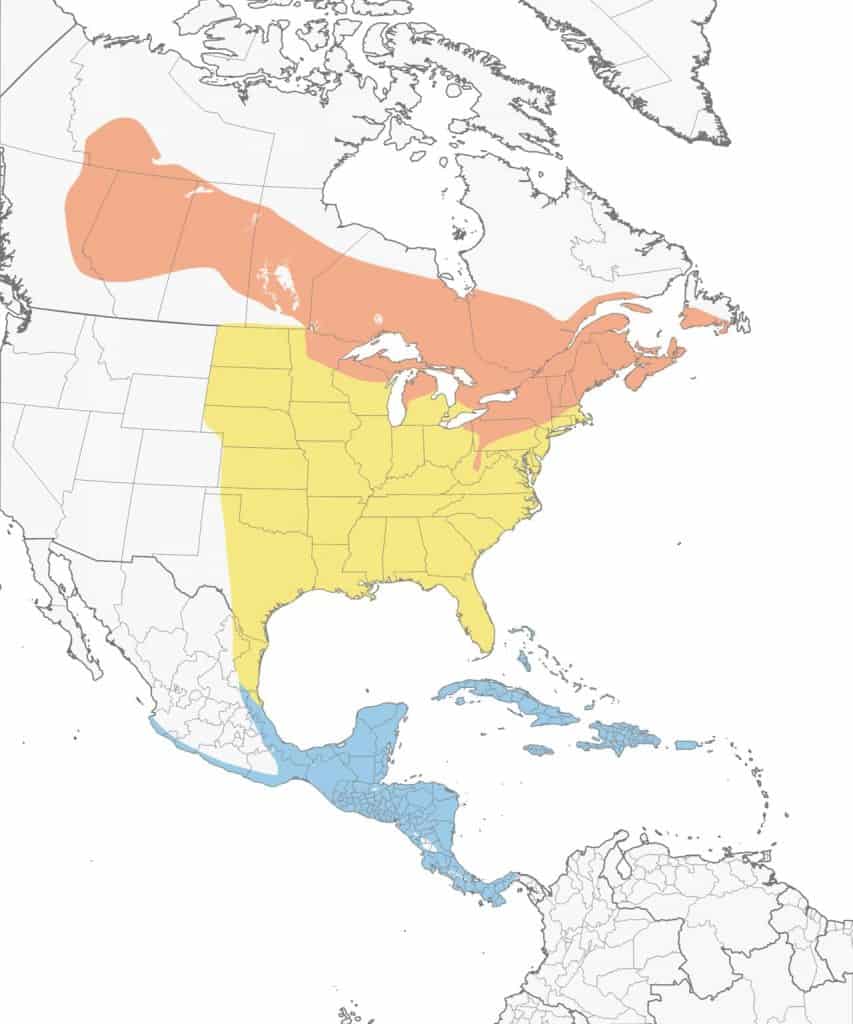
Orchard Oriole
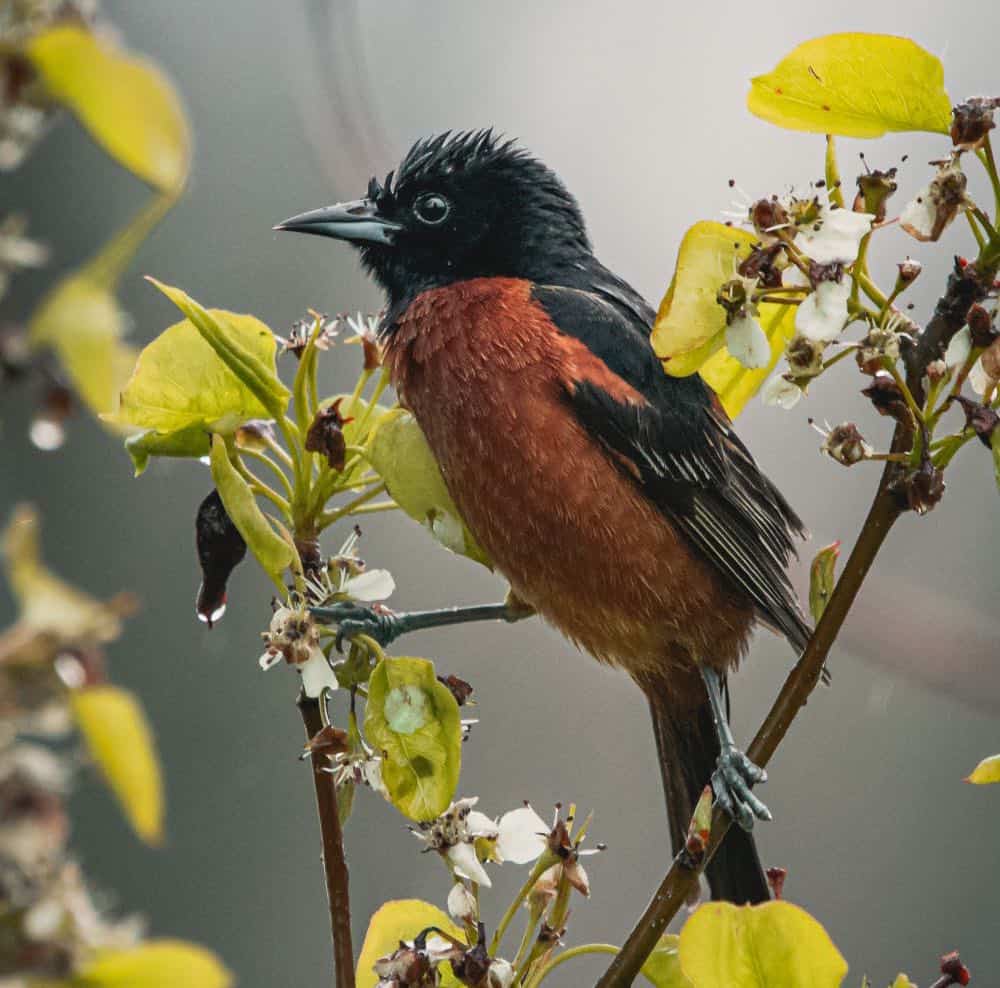
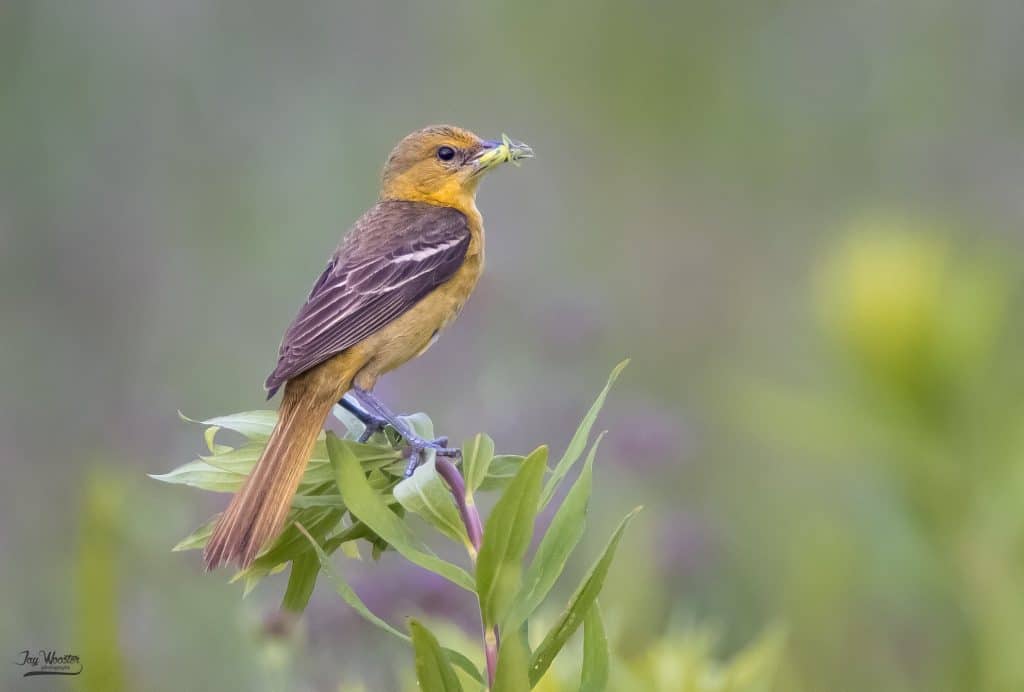
| Appearance | The orchard oriole is a medium-sized bird about 7″ long. The male has black upperparts and orange-chestnut underparts. They have a pointy bill that points downward. The female is a pale yellow with black wings and white wingbars. |
| Diet | Insects, spiders, fruits, and nectar. |
| Feeder Food | Cut fruit and nectar. |
| Habitat | This bird prefers open woodlands along waterways as well as open shrubby areas. |
| Nesting | They nest on the outer branches of a tree between 10-50′ up. Their nest is cup-shaped and hangs about 4″ long. They have 1-2 broods/season, 4-6 eggs/rood, and incubate for 12-14 days. Fledglings leave the nest at about 11-14 days. |
Range Map
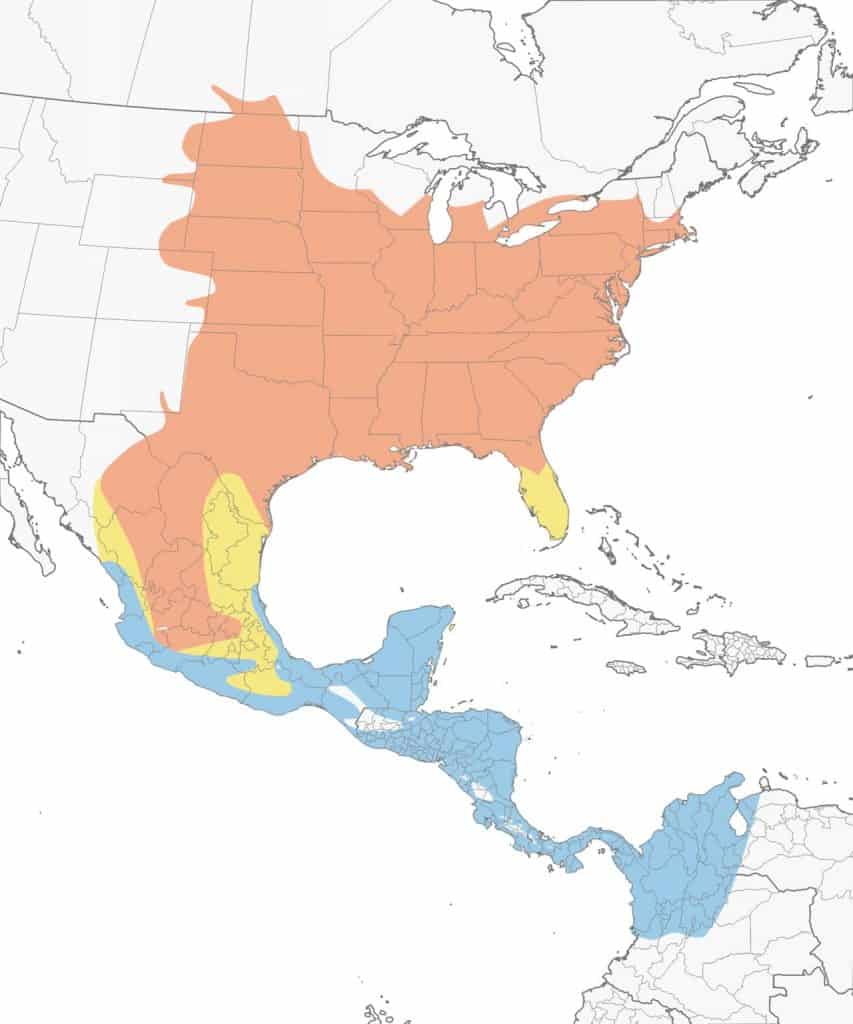
Prothonotary Warbler
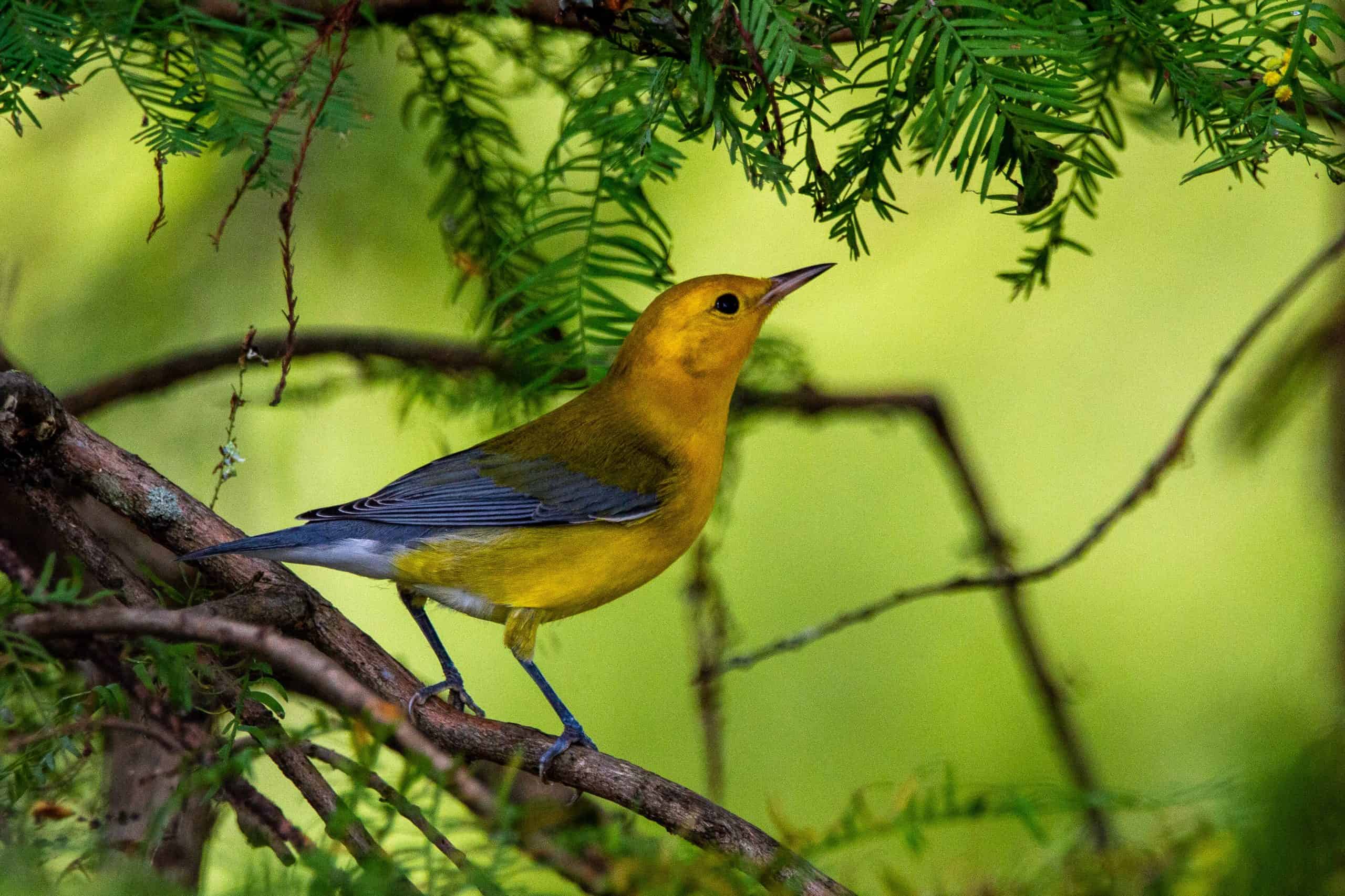
| Appearance | |
| Diet | |
| Feeder Food | |
| Habitat | |
| Nesting |
Range Map
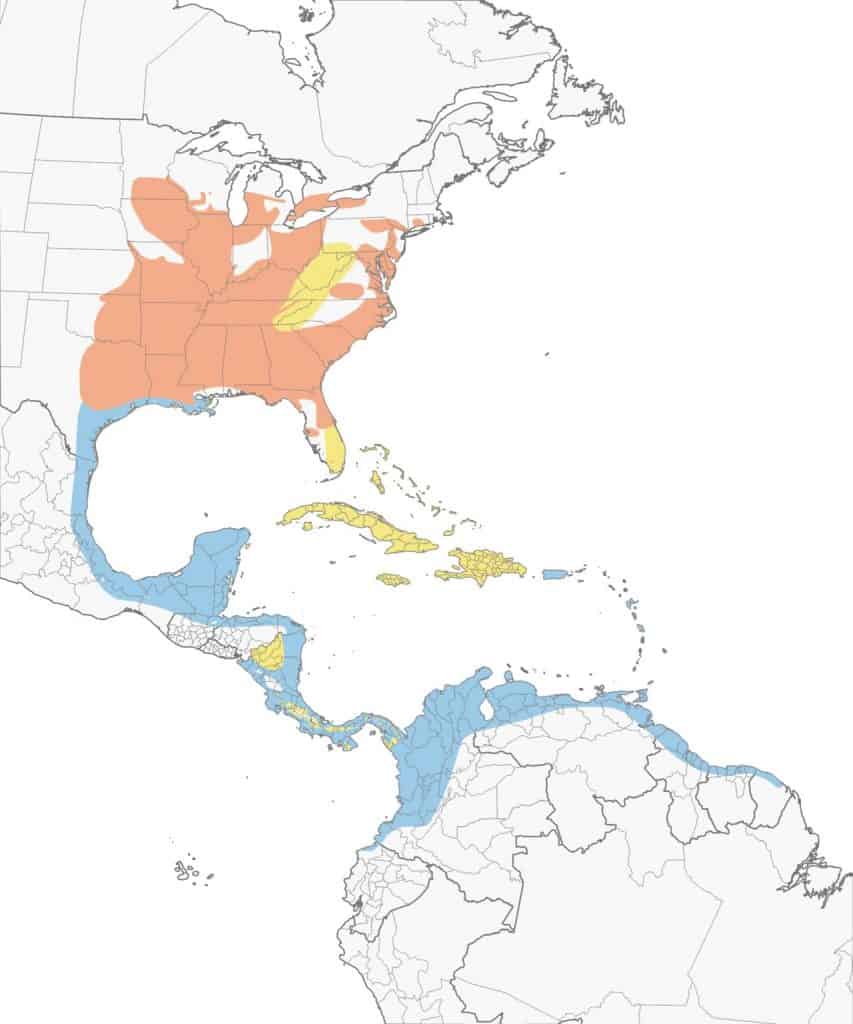
Scarlet Tanager
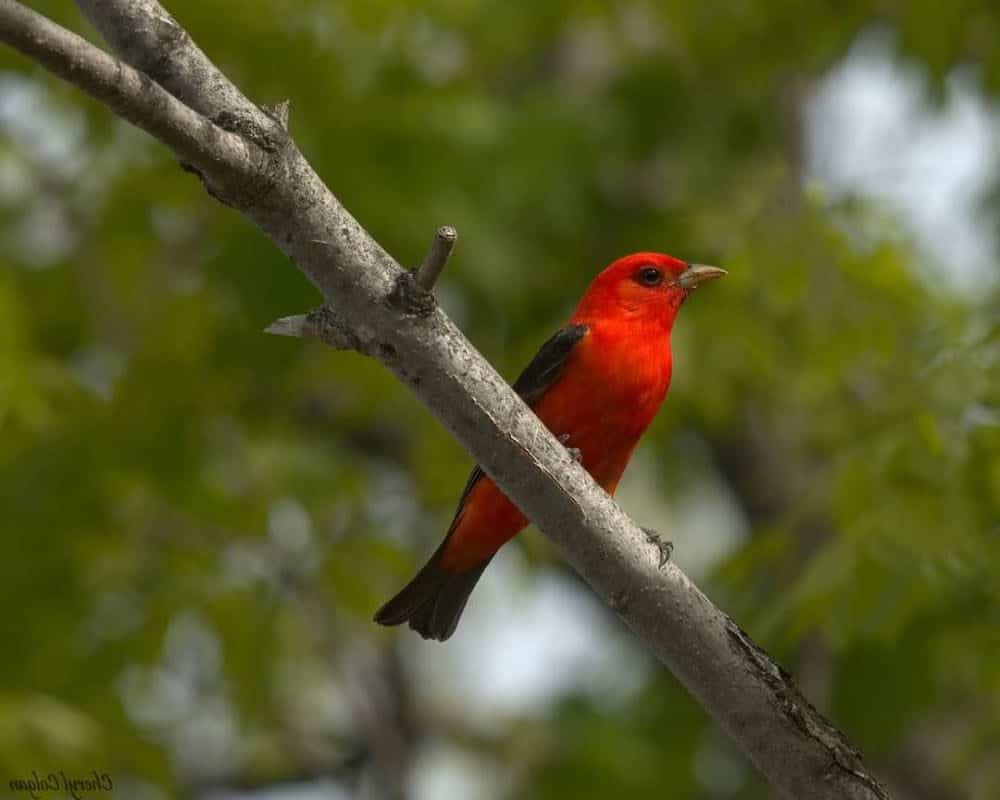
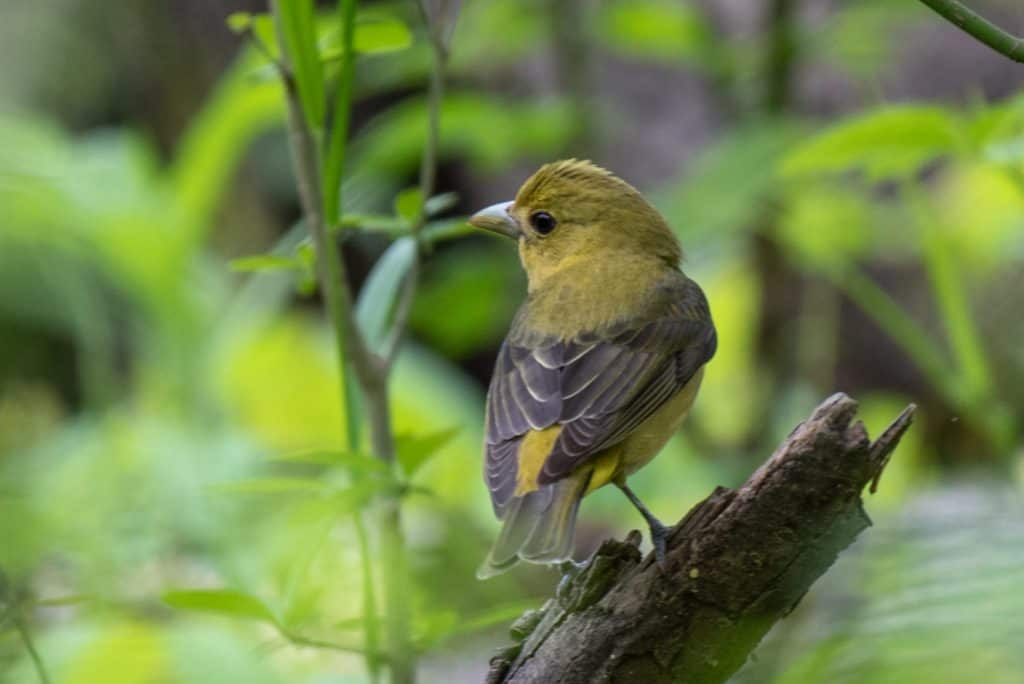
Appearance: Scarlet tanagers are small birds about 6.5″ long, with vibrant red faces and bodies (although many consider them to be a deep shade of orange), tan beaks, black wings, and short black tails. No crown. The female scarlet tanager (and juveniles) are the same except yellow instead of red.
Diet: Insects in summer; fruit in fall/winter.
Feeder food: Scarlet tanagers are unlikely to visit feeders. However, you can attract them by planting berry-producing plants such as blackberries, raspberries, huckleberries, juneberries, serviceberries, mulberries, and strawberries.
Habitat: Thickly forested regions in the eastern US. Often spotted high in the treetops.
Nesting: A loosely constructed nest of grass, twigs, bark strips, pine needs, and other plant materials. The nest rests high in a deciduous tree out in the middle of a horizontal branch about 50′ up. 1 brood/season, 3-5 eggs/brood, eggs are green/blue with multicolored and shaded marks of brown, purple/red. Incubation is 12-14 days and the young fledge is between 9-15 days.
Migration: Scarlet tanagers are migrators. In the spring, they migrate north to breed and raise their young. In the fall, they migrate south for the winter.
Breeding range: Primarily the eastern half of the US (except Florida and Louisiana), as well as the southern part of Canada’s Manitoba, Saskatchewan, and Ontario.
Winter range: South America.
Range Map
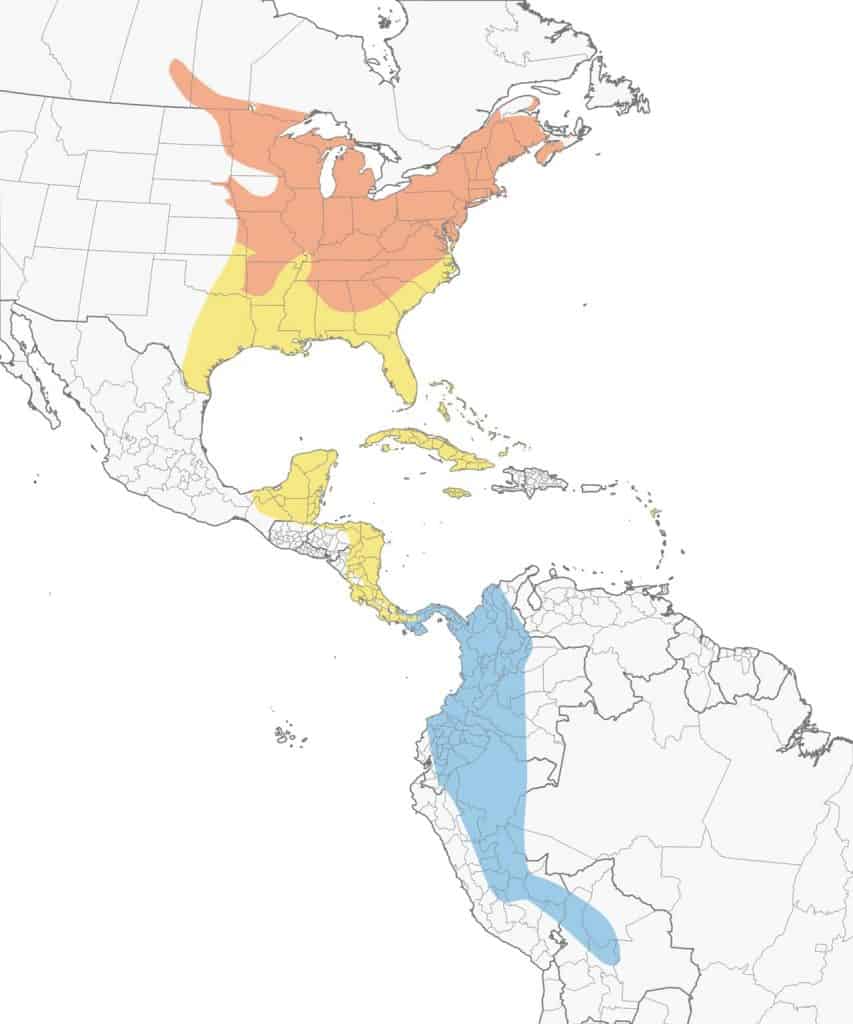
Scott’s Oriole
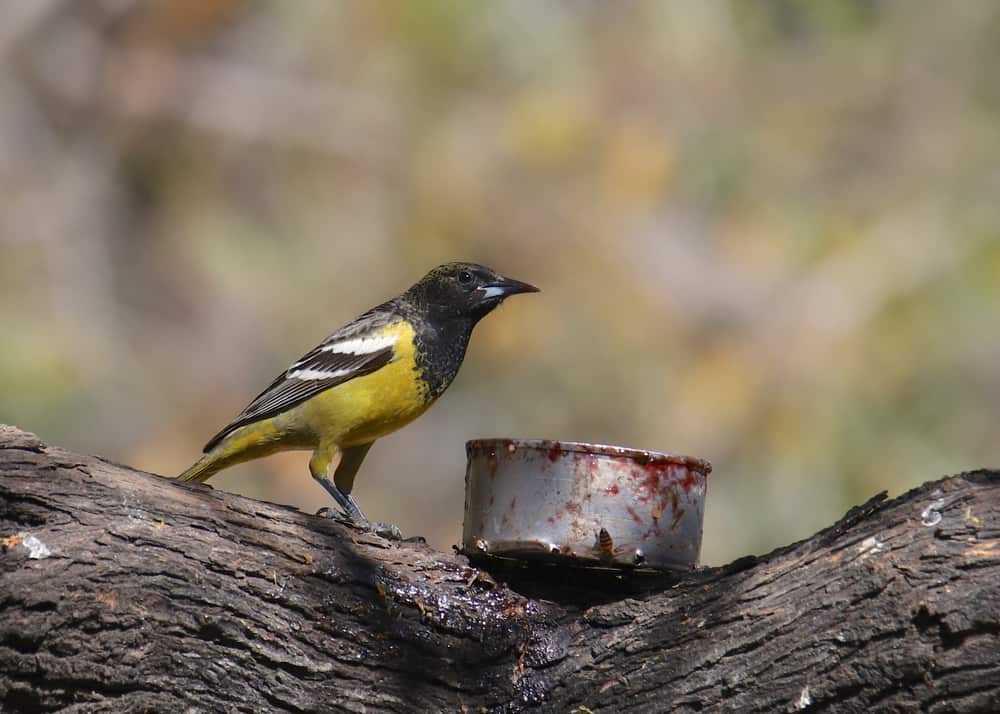
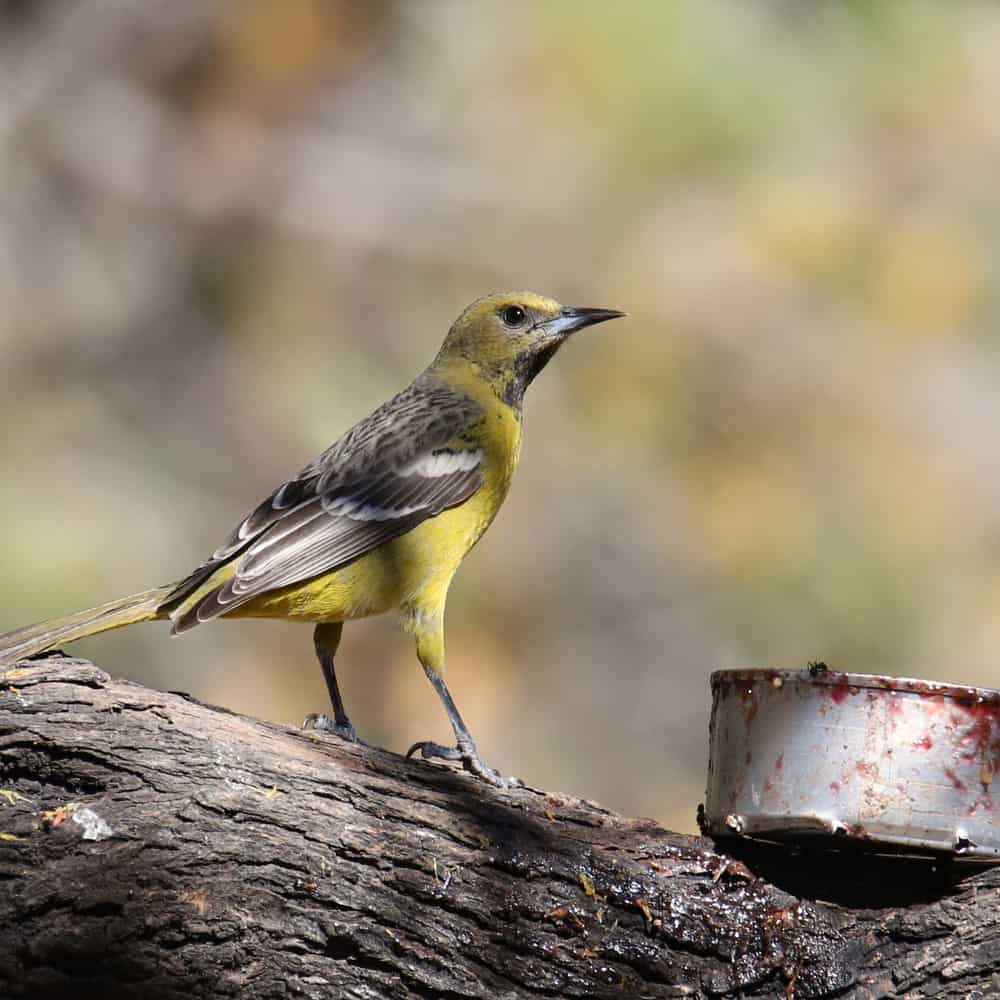
| Appearance | Scott’s oriole is a large bird about 9″ long. They have a black head, back, and wings with white spots. The belly is a bright yellow. Females are pale yellow throughout with gray/brown wings. |
| Diet | Insects, fruit, and nectar. |
| Feeder Food | Fruit, especially oranges and nectar. |
| Habitat | Found primarily in the foothills, mountains, and deserts areas of their range. |
| Nesting | This oriole bird places their nest about 5-7 above the ground, is constructed with a large variety of materials, and shaped like a basket. They have 1 brood/season, 1-5 eggs/brood that are pale blue with spots. |
Range Map
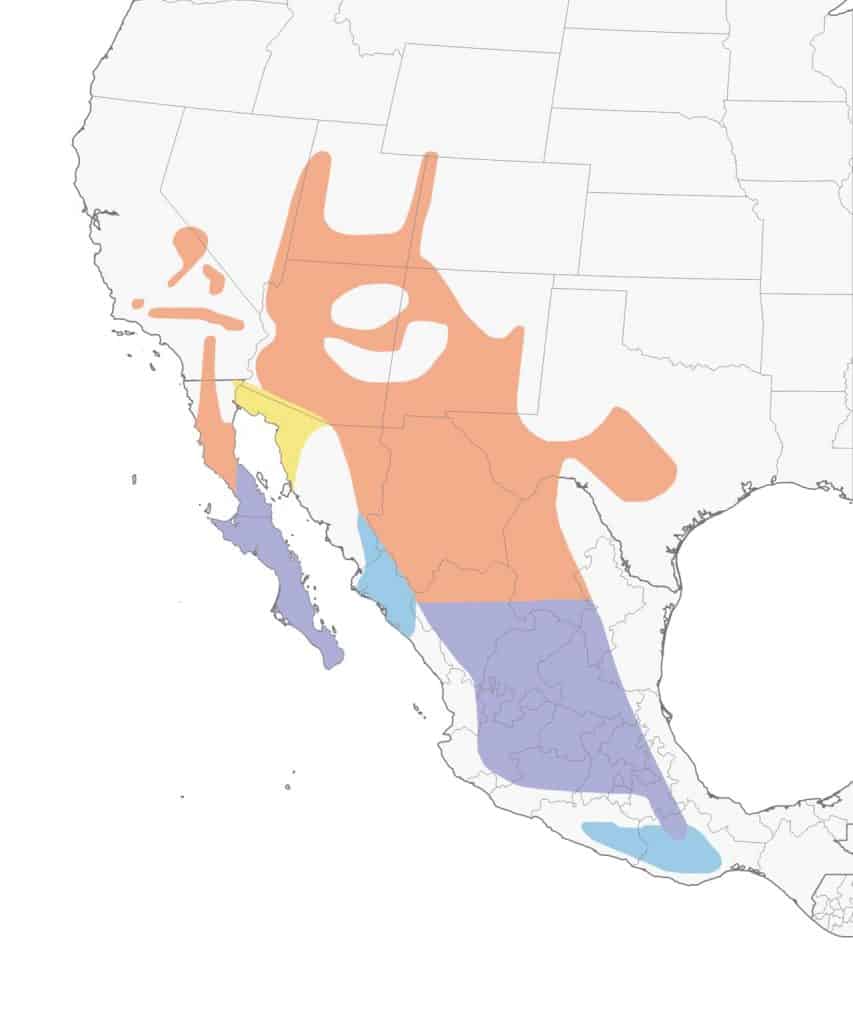
Townsend’s Warbler
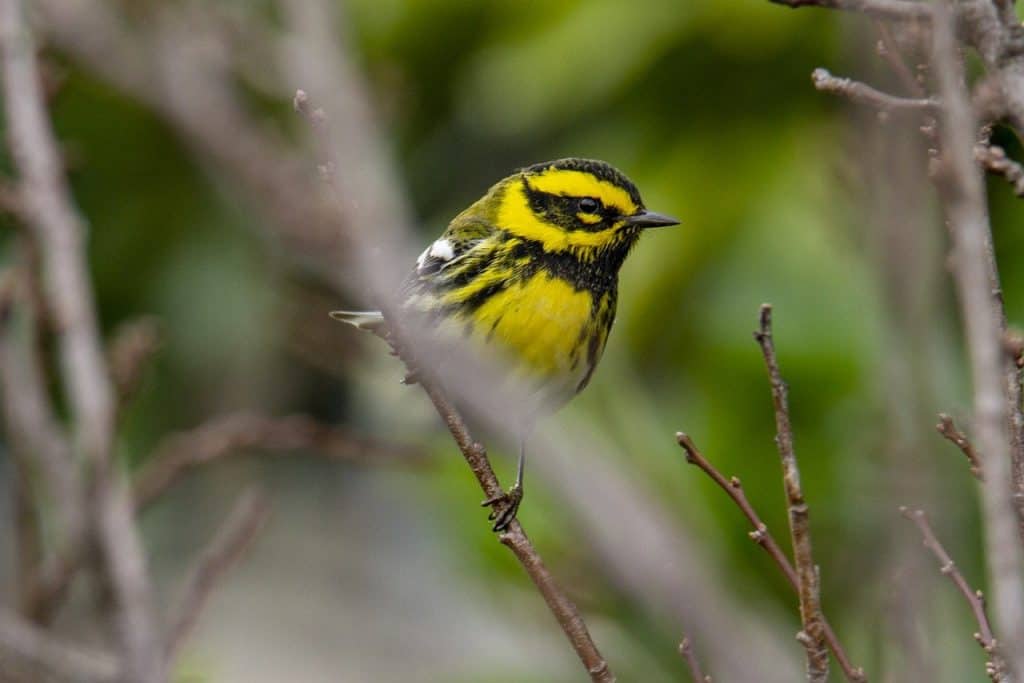
| Appearance | The Townsend’s warbler is a small bird about 5″ long with bright yellow on its face and chest and dark yellow on its back. Black on the crown, throat, and circle around and under each eye. They also have black wings and streaks of black on the white belly and chest. Females are the same except for more subtle markings. |
| Diet | Insects and their larvae. Occasionally spiders and seeds. |
| Feeder Food | Mealworms and suet. |
| Habitat | Wooded areas with tall, mature coniferous, and deciduous trees. |
| Nesting | They build a cup-shaped and place it in conifers about 3′ up. They have 1 brood/season, 3-7 eggs/brood, and incubate for 11-14 days. the eggs are with brown specks. |
Range Map
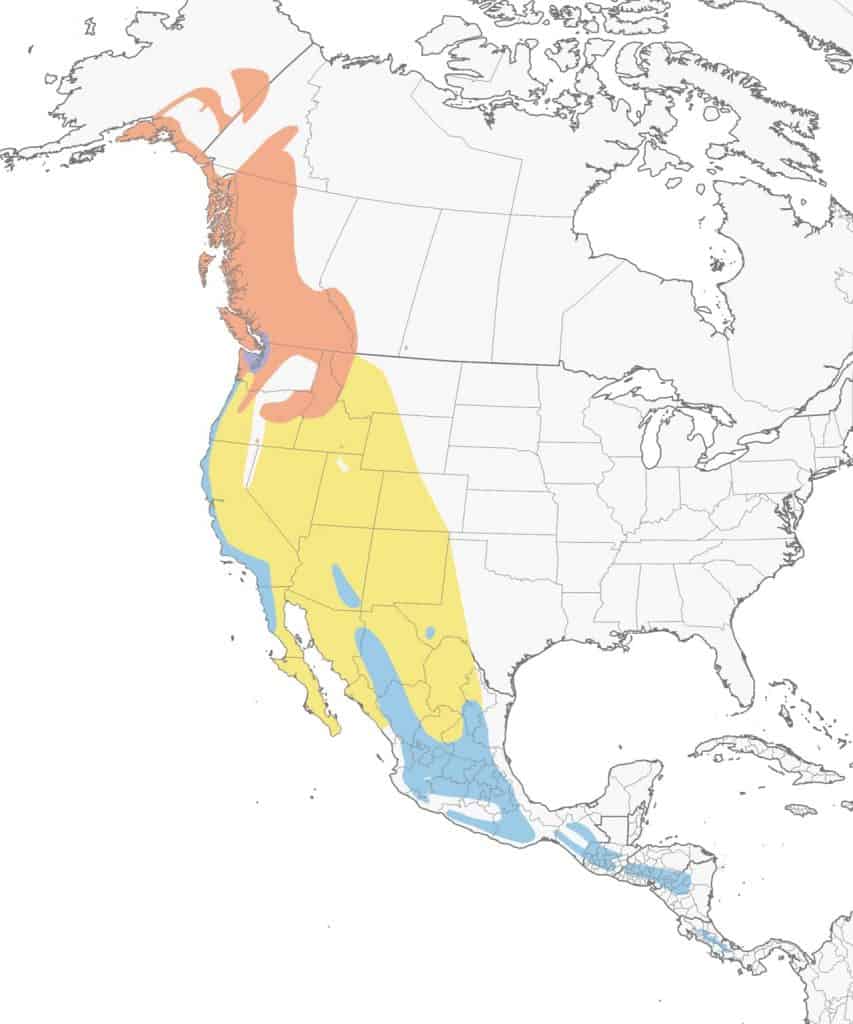
Western Tanager
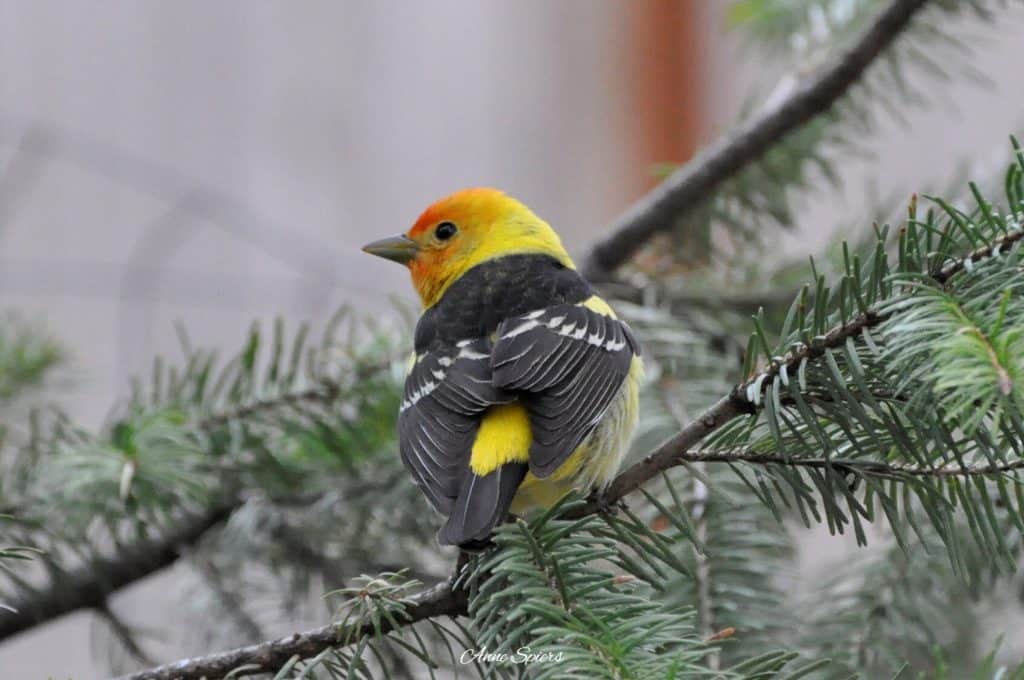
Appearance: The western tanager is a medium-sized bird about 7 1/4″ long with a bright red-orange head, black-and-yellow wings, and bright yellow chest. The female does not have a red-orange head. Instead, she’s an olive-yellow color throughout.
Diet: Insects and occasionally fruits and berries.
Feeder food: Western tanagers are unlikely feeder visitors but may be enticed with fruit or grape jelly.
Habitat: Open woodlands, especially when pine, oak, and conifers are present. Higher elevations are preferred.
Nesting: The cup-shaped nest is placed high in a conifer tree, up to 60′ up. They have 4 eggs/brood and incubate for about 13-14 days.
Migration: Western tanagers are migrators. In the spring they head north into Canada’s Yukon Territory, British Columbia, Alberta, and Saskatchewan as well as the U.S. states Washington, Idaho, Montana, Oregon, Wyoming, California, Nevada, Utah, Colorado, Arizona, and New Mexico. In the fall, they head back south to winter in Mexico.
Range Map
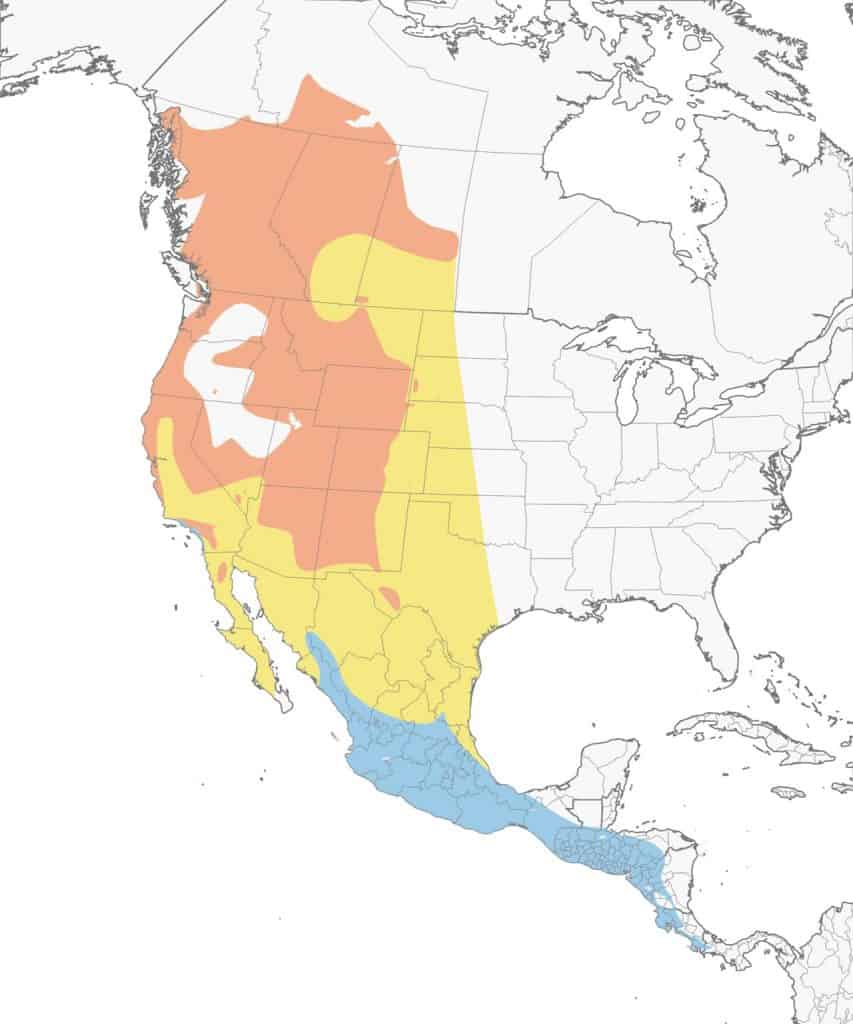
Wilson’s Warbler
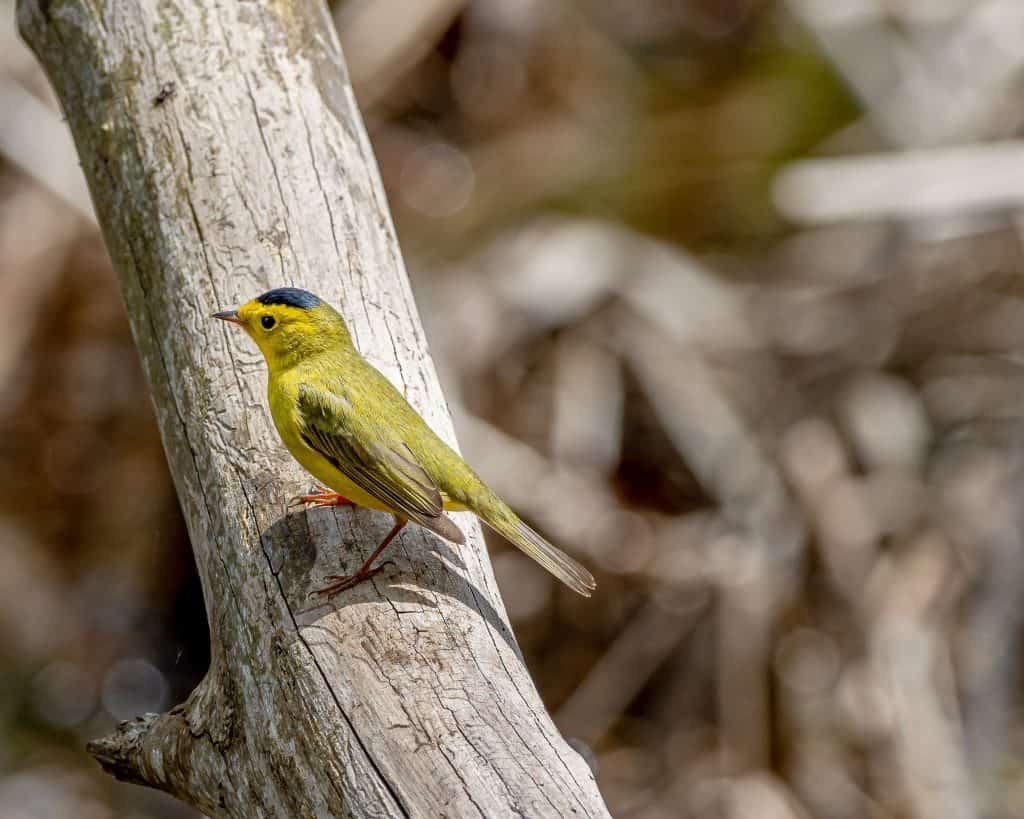
Appearance: Wilson’s warbler is a very small bird about 4-5″ long. They’re bright yellow with subdued tones of the olive-yellow outside of the face, a black cap (looks a bit like a toupe), and black wings with white stripes. Their bills are short and pointy, eyes dark black.
The female is the same except the cap is light charcoal.
Diet: Insects, especially larval insects, spiders, and the sugary liquid from scale insects (tiny insects that feed on plants).
Feeder food: Unlikely to visit a feeder.
Habitat: Forested edges, shrubby thickets, and often young conifer trees.
Nesting: Wilson’s warblers place their 3-4″ nest on the ground. Sometimes nests are in shrubs in which case they are a bit bigger. They have 1-2 broods/season and 2-7 eggs/brood that are white/ivory with reddish/brown specks. Incubation is for 10-13 days and juveniles leave the nest at about 9-11 days.
Migration: Wilson’s warblers are migrators. In the spring they migrate north to breed and raise their young. Then in the fall, they migrate back south for the winter.
Breeding range: Alaska, Washington, Oregon, Idaho, western Montana, northern and the coast of California, as well as irregular patches in Wyoming, Utah, Colorado, New England, and Canada’s provinces (except Nunavut).
Winter range: Southeast Texas, southern Louisiana, and Mexico.
Range Map
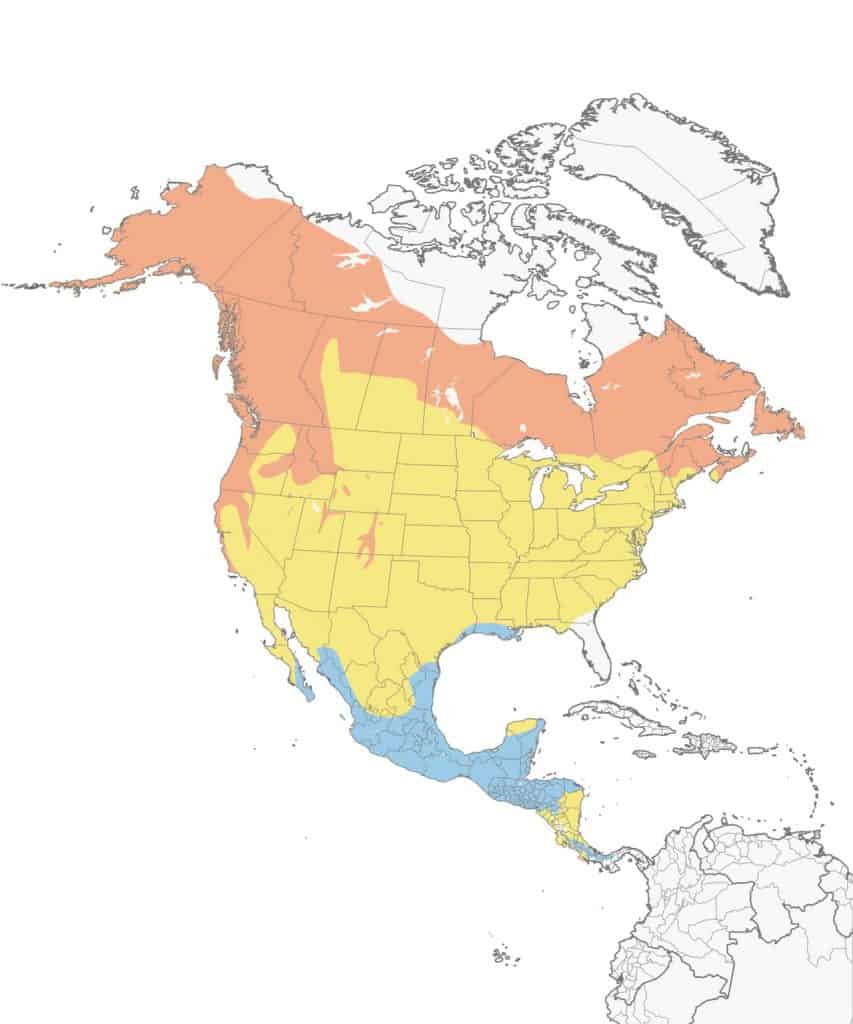
Yellow Warbler
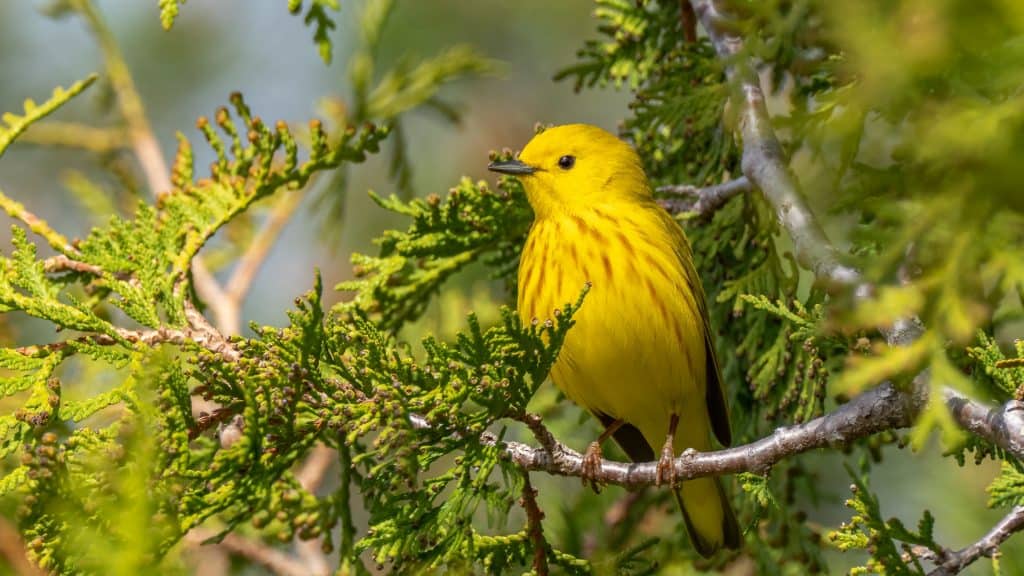
Appearance: The yellow warbler is a small bird about 5″ long primarily yellow with orange streaks on the chest and belly, and black-streaked wings. Bill is long, pointy, and gray. The Female is a muted olive-green version of the male without the orange chest.
Diet: Insects
Feeder food: Unlikely to visit a feeder.
Habitat: Shrubby areas and gardens, willows, wet thickets, and roadsides.
Nesting: Yellow warblers construct a cup-shaped nest to raise 1 brood/year. They have 4-5 eggs/brood that are white with brown markings. Incubation lasts 11-12 days.
Migration: Yellow warblers are migrators. In the spring, they migrate north to breed and raise their young. Then in the fall, they migrate back south for the winter.
Breeding range: All US states except Texas, Louisiana, Mississippi, and Florida. Also, all of Canada as well as central Mexico.
Winter range: Along the California and Arizona state lines, Pacific and Atlantic coasts of Mexico, Central America, and South America.
Range Map
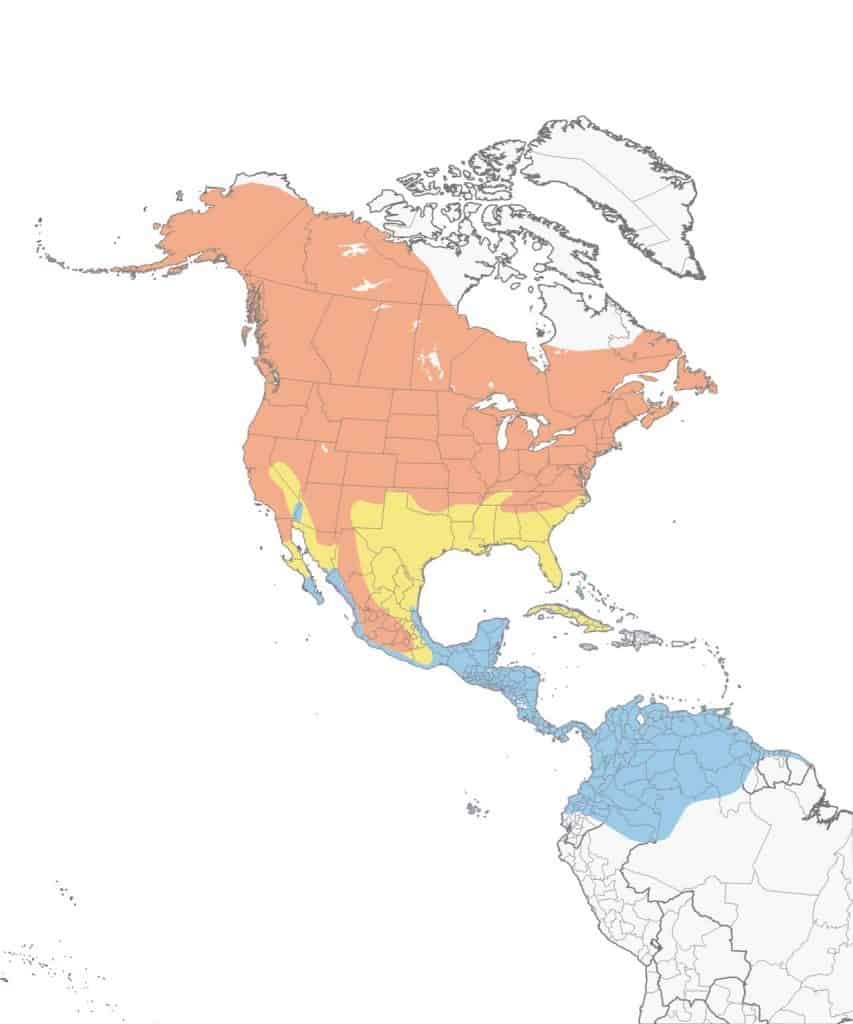
Yellow-Headed Blackbird
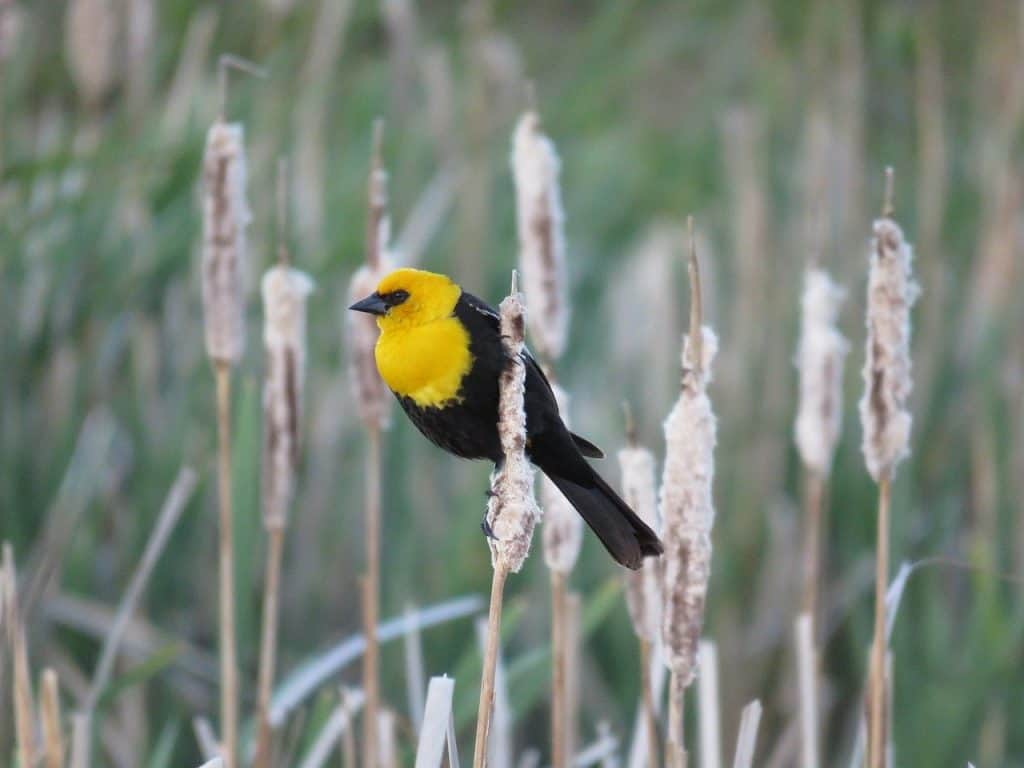
| Appearance | The yellow-headed blackbird is a large bird about 9-11″ long They are all black with a golden yellow head, chest, and back of its neck. A black mask and gray bill accent the face. The wings have white patches and they have a pointy black bill. The female is similar to the male except she’s slightly smaller, and has a brown body with a dull yellow head and chest. |
| Diet | Insects and seeds. |
| Feeder Food | Unlikely to visit a feeder. |
| Habitat | Wetland areas such as marshes. |
| Nesting | Cup-shaped nest. They have 2 broods/year and 3-5 greenish-white eggs/brood with brown markings. Incubation is 11-13 days. |
Range Map
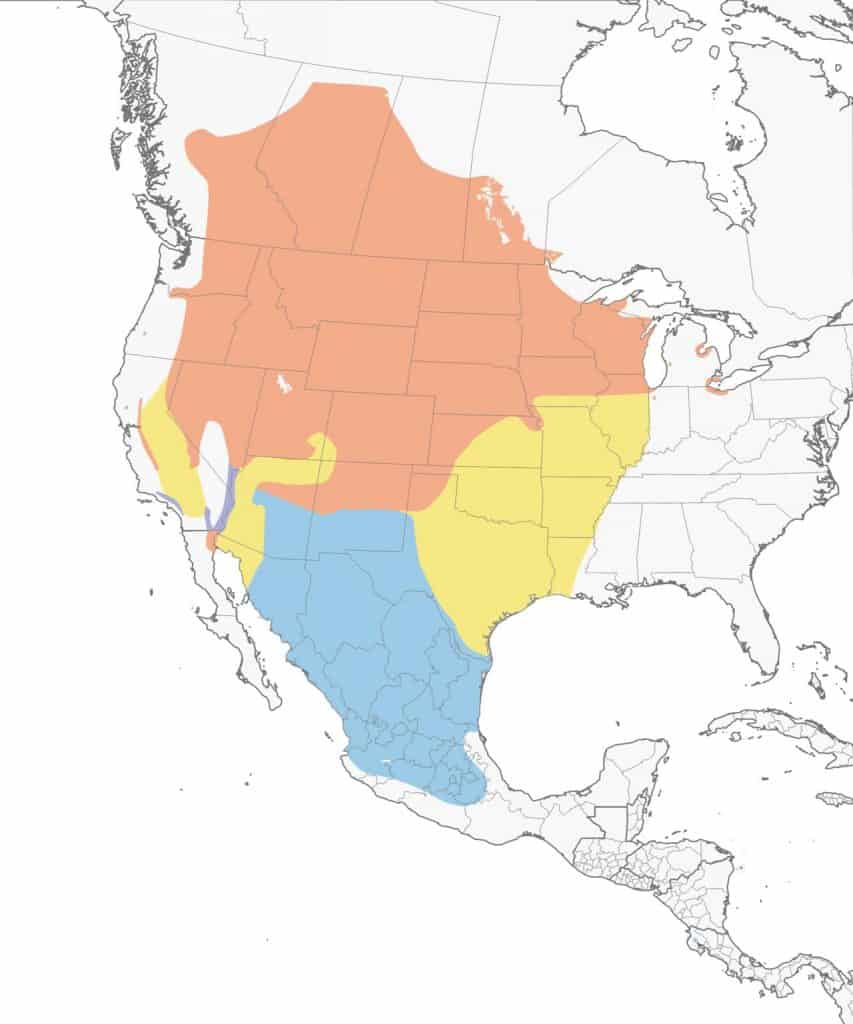
Conclusion
Hopefully, you’ve identified the yellow bird with black wings you were looking for or just broadened your knowledge of yellow black-winged birds in North America. If you want to see more of a particular species of these yellow birds, consider taking steps to attract them to your yard.
Happy Birding!
